Vol. 71, No. 5 (2022)
2022-03-05
REVIEW
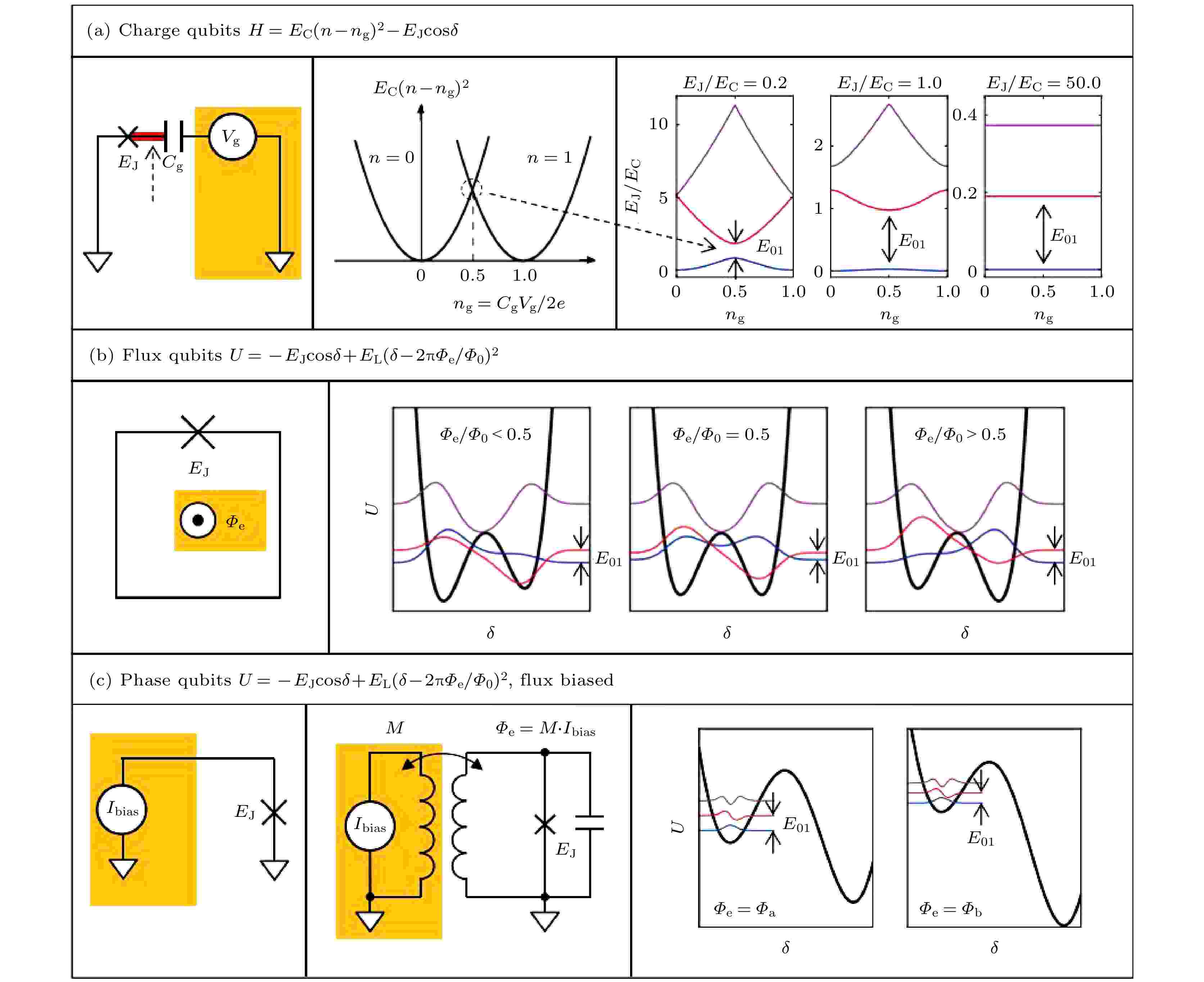
EDITOR'S SUGGESTION
2022, 71 (5): 050303.
doi:10.7498/aps.71.20211865
Abstract +
Over the past two decades significant advances have been made in the research of superconducting quantum computing and quantum simulation, in particular of the device design and fabrication that leads to ever-increasing superconducting qubit coherence times and scales. With Google’s announcement of the realization of “quantum supremacy”, superconducting quantum computing has attracted even more attention. Superconducting qubits are macroscopic objects with quantum properties such as quantized energy levels and quantum-state superposition and entanglement. Their quantum states can be precisely manipulated by tuning the magnetic flux, charge, and phase difference of the Josephson junctions with nonlinear inductance through electromagnetic pulse signals, thereby implementing the quantum information processing. They have advantages in many aspects and are expected to become the central part of universal quantum computing. Superconducting qubits and auxiliary devices prepared with niobium or other hard metals like tantalum as bottom layers of large-area components have unique properties and potentials for further development. In this paper the research work in this area is briefly reviewed, starting from the design and working principle of a variety of superconducting qubits, to the detailed procedures of substrate selection and pretreatment, film growth, pattern transfer, etching, and Josephson junction fabrication, and finally the practical superconducting qubit and their auxiliary device fabrications with niobium base layers are also presented. We aim to provide a clear overview for the fabrication process of these superconducting devices as well as an outlook for further device improvement and optimization in order to help establish a perspective for future progress.
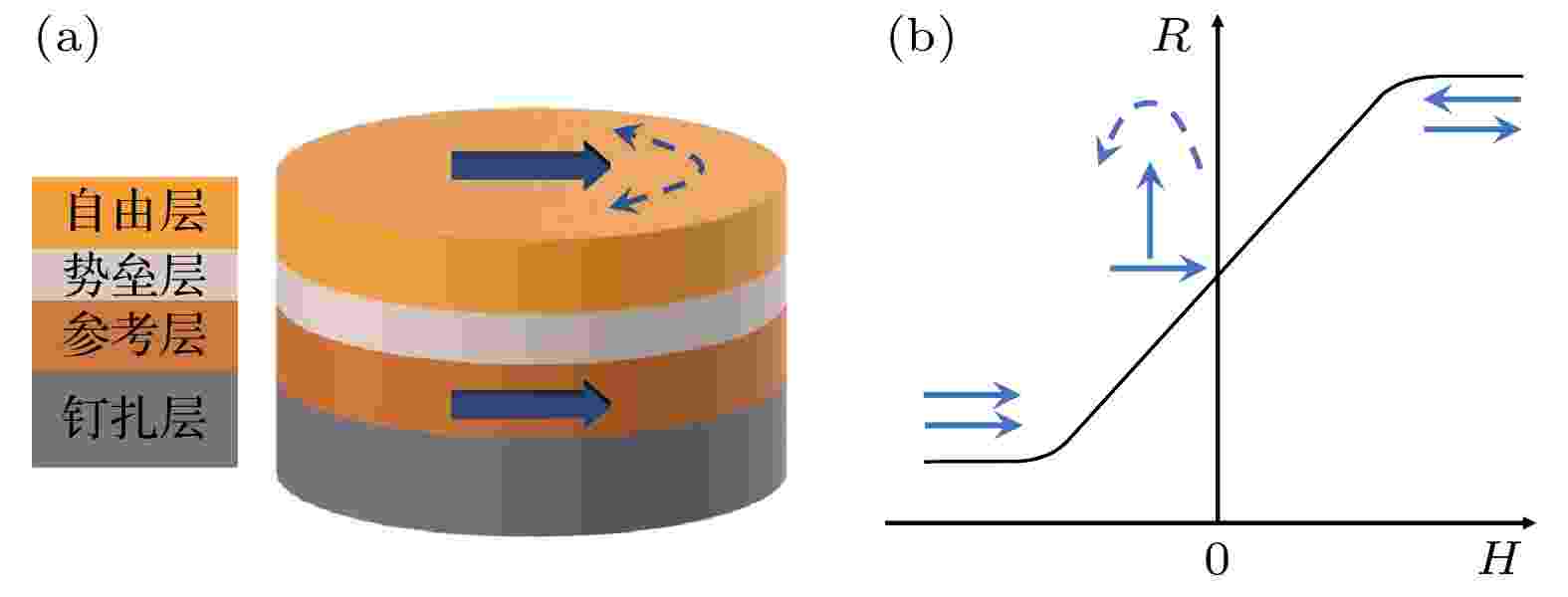
EDITOR'S SUGGESTION
2022, 71 (5): 058504.
doi:10.7498/aps.71.20211883
Abstract +
Sensors play an important role in Internet of Things (IoT) industry and account for a rapidly growing market share. Among them, the magnetic sensor based on tunneling magnetoresistance (TMR) effect possesses great potential applications in the fields of biomedical, navigation, positioning, current detection, and non-destructive testing due to its extremely high sensitivity, small device size and low power consumption. In this paper, we focus on the development of TMR sensor technology routes, covering a series of research advances from a sensor transducer to three-dimensional magnetic field detection, and then to the applications. Firstly, we recall the development history of TMR sensors, explain its working principle, and discuss the method to improve the output linearity of single magnetic tunnel junction. Next, we state the Wheatstone-bridge structure, which can inhibit temperature drift in detail and review several methods of fabricating the full bridge of TMR sensors. Furthermore, for the market demand of three-dimensional magnetic field detection, we summarize the methods of designing and fabricating three-dimensional sensing structure of the TMR sensor. At the same time, we list several optimization schemes of TMR sensor performance in terms of sensitivity and noise level. Finally, we discuss two types of emerging applications of TMR sensors in recent years. The TMR sensors can also be used in intelligence healthcare due to their ultra-high sensitivity. In addition, devices from the combination of spin materials and MEMS structure have attracted wide attention, especially, because of the large commercial market of microphones, spin-MEMS microphones utilized TMR techniques will be the next research hotspot in this interdisciplinary field.
GENERAL
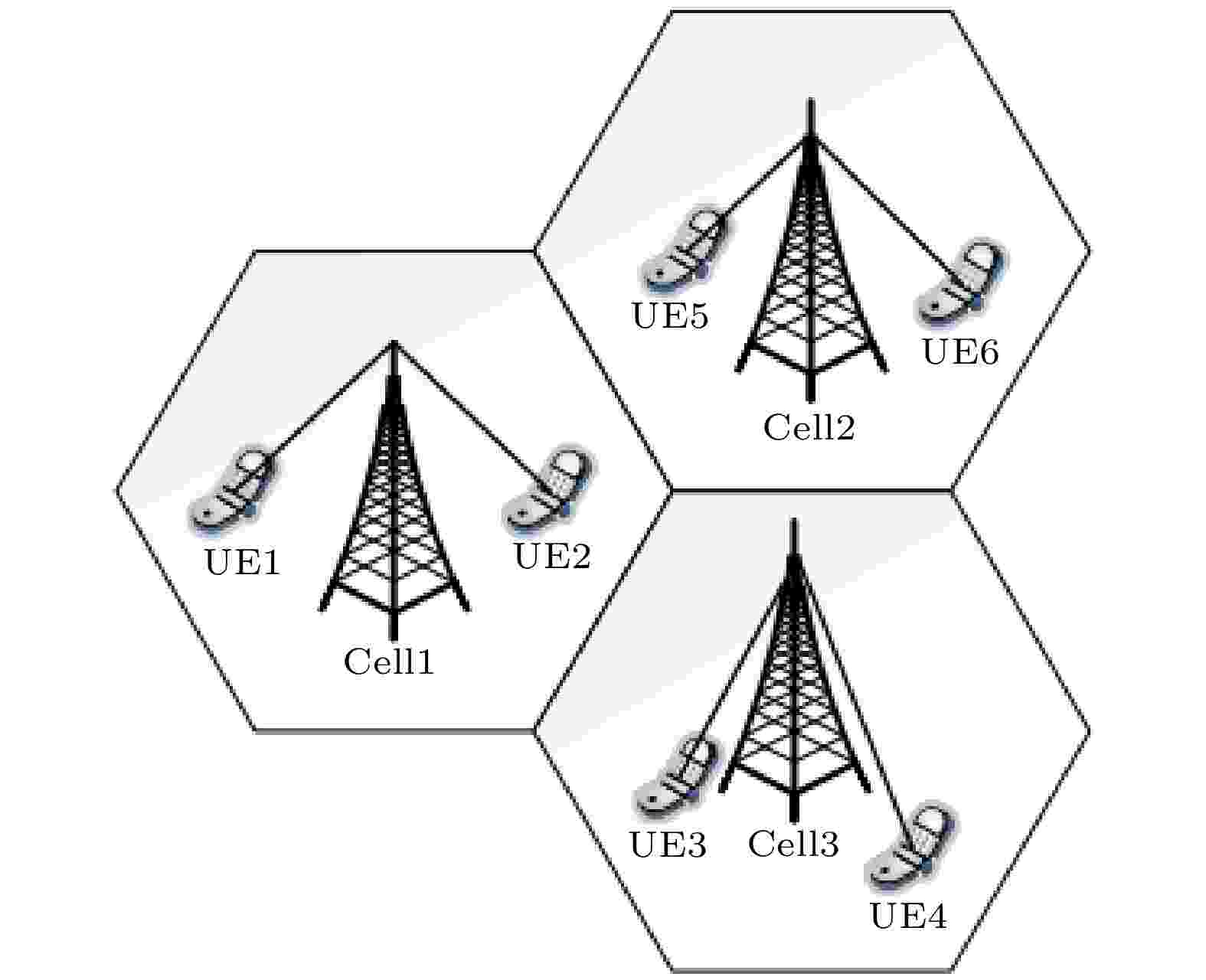
2022, 71 (5): 050101.
doi:10.7498/aps.71.20211504
Abstract +
Aiming at the pilot design problem in channel estimation of large-scale multiple input multiple output (MIMO) systems, an adaptive autocorrelation matrix reduction parameter pilot optimization algorithm based on channel reconstruction error rate minimization is proposed under the framework of compression perception theory. Firstly, the system model and orthogonal matching pursuit (OMP) algorithm are introduced. Secondly, for minimizing the channel reconstruction error rate, the relation between the expected value of the correlation decision in each iteration of the OMP algorithm and the reconstruction error rate is analyzed. For the optimal expected value of the correlation decision, the relation between the channel reconstruction error rate and the correlation of the pilot matrix column under the OMP algorithm is derived, and the two criteria of optimizing the pilot matrix are obtained: the pilot matrix column correlation expectation and the variance minimization. Then the method of optimizing the pilot matrix is studied, and the corresponding adaptive autocorrelation matrix reduction parameter pilot matrix optimization algorithm is proposed. In each iteration, whether the average column correlation degree of the matrix to be optimized is reduced is used as a judgment condition. The autocorrelation matrix reduction parameter value is adjusted to make the parameters close to the theoretical optimization. The simulation results show that the proposed method has a better column correlation property and lower channel reconstruction error rate than the pilot matrix obtained, separately, by Gaussian matrix, Elad method and low power average column correlation method.

EDITOR'S SUGGESTION
2022, 71 (5): 050301.
doi:10.7498/aps.71.20211324
Abstract +
Two-mode entangled state is an important quantum resource for quantum information. In this paper, the amplification of a single mode of two-mode entangled state (single-mode amplification scheme) and two modes of two-mode entangled state (two-mode amplification scheme) are theoretically proposed. Here, the optical beam splitter model is used to simulate the vacuum noise introduced by the loss in the optical transmission process. By utilizing the positivity under partial transpose criterion, we analyze the effect of the gain of the four-wave mixing process on the entanglement degree of the initial two-mode entangled state in two different amplification schemes. In these two schemes, we set the gain of the initial two-mode entangled state generation process to be 1.5, 2.5 and 50.0 respectively, and then change the gain of the amplification process in a certain range. We also set the transmission efficiency of the amplified beams for each of the two schemes to be a definite value. The results show that the entanglement of the initial two-mode entangled state decreases with the gain increasing under the condition of specific transmission loss in two schemes. When the gain does not exceed a certain value, the entanglement of the initial two-mode entangled state can be maintained. Then, with the increase of the gain, the entanglement of the initial two-mode entangled state will disappear. Moreover, the entanglement of the initial two-mode entangled state of the two-mode amplification scheme disappears faster than that of the single-mode amplification scheme. Our theoretical results pave the way for the experimental realization of the amplification of two-mode entangled state based on four-wave mixing process.
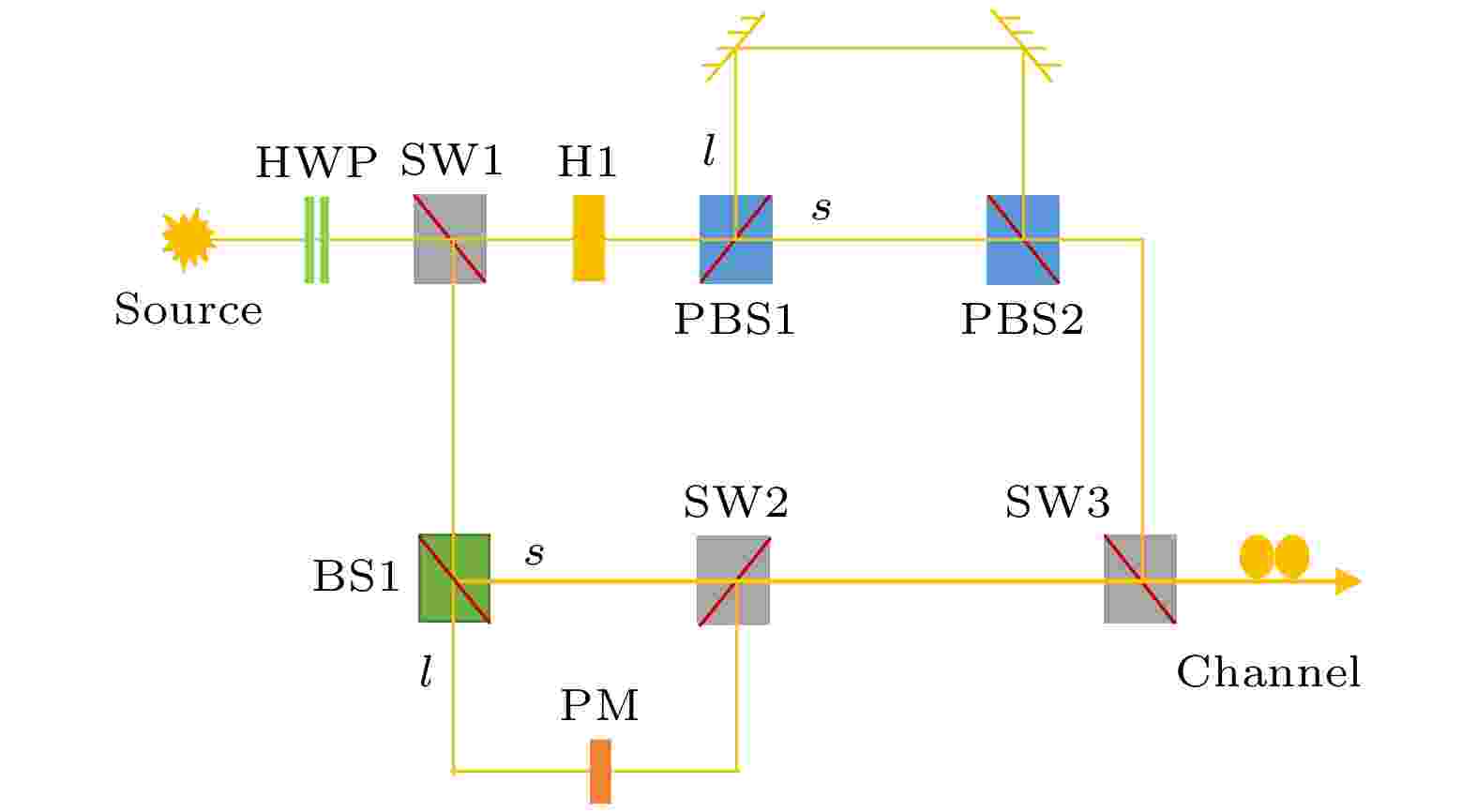
EDITOR'S SUGGESTION
2022, 71 (5): 050302.
doi:10.7498/aps.71.20210907
Abstract +
Quantum communication is an important branch of quantum technology. It can safely transmit private information between legitimate parties and its unconditional security is guaranteed by quantum physics. So far, deterministic secure quantum communication without entanglement usually transmits single photons in two-way quantum channels. We propose a deterministic secure quantum communication proposal, and it requires a one-way quantum channel and a classical channel. In our protocol, a sender encodes logical bits by using two conjugate bases consisting of the polarization and time-bin degrees of freedom of a photon and transmits it to a receiver over a quantum channel. Upon receiving this photon, the receiver measures it randomly in two bases and can decode the bit deterministically with the help of the sender. Any attack from eavesdroppers will be detected by the legitimate parties. Furthermore, this protocol can be implemented with linear-optic elements and single-photon detectors.

2022, 71 (5): 050501.
doi:10.7498/aps.71.20211656
Abstract +
The visibility graph algorithm proves to be a simple and efficient method to transform time series into complex network and has been widely used in time series analysis because it can inherit the dynamic characteristics of original time series in topological structure. Now, visibility graph analysis of univariate time series has become mature gradually. However, most of complex systems in real world are multi-dimensional, so the univariate analysis is difficult to describe the global characteristics when applied to multi-dimensional series. In this paper, a novel method of analyzing the multivariate time series is proposed. For patients with myocardial infarction and healthy subjects, the 12-lead electrocardiogram signals of each individual are considered as a multivariate time series, which is transformed into a multiplex visibility graph through visibility graph algorithm and then mapped to fully connected complex network. Each node of the network corresponds to a lead, and the inter-layer mutual information between visibility graphs of two leads represents the weight of edges. Owing to the fully connected network of different groups showing an identical topological structure, the dynamic characteristics of different individuals cannot be uniquely represented. Therefore, we reconstruct the fully connected network according to inter-layer mutual information, and when the value of inter-layer mutual information is less than the threshold we set, the edge corresponding to the inter-layer mutual information is deleted. We extract average weighted degree and average weighted clustering coefficient of reconstructed networks for recognizing the 12-lead ECG signals of healthy subjects and myocardial infarction patients. Moreover, multiscale weighted distribution entropy is also introduced to analyze the relation between the length of original time series and final recognition result. Owing to higher average weighted degree and average weighted clustering coefficient of healthy subjects, their reconstructed networks show a more regular structure, higher complexity and connectivity, and the healthy subjects can be distinguished from patients with myocardial infarction, whose reconstructed networks are sparser. Experimental results show that the identification accuracy of both parameters, average weighted degree and average weighted clustering coefficient, reaches 93.3%, which can distinguish between the 12-lead electrocardiograph signals of healthy people and patients with myocardial infarction, and realize the automatic detection of myocardial infarction.
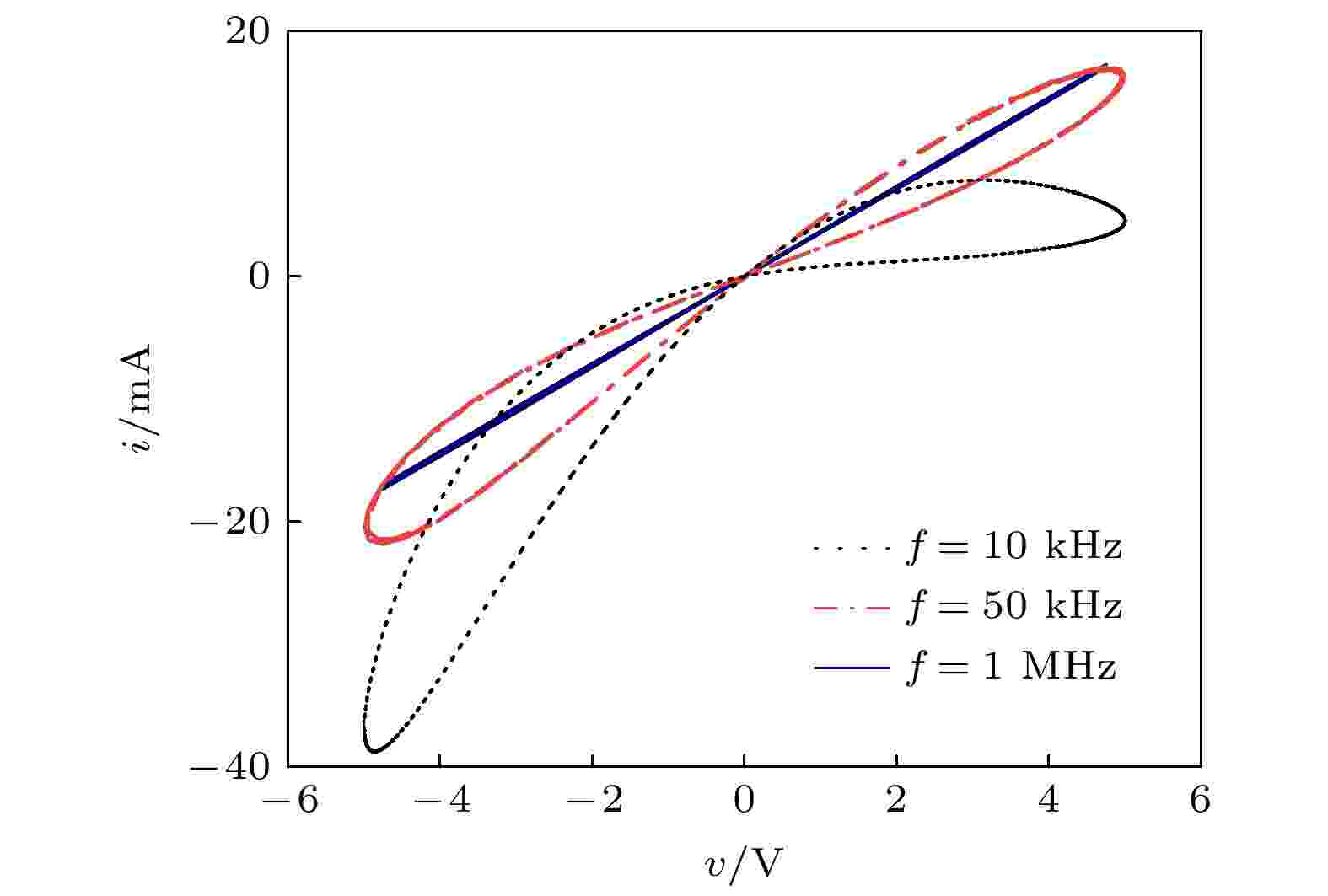
2022, 71 (5): 050502.
doi:10.7498/aps.71.20212017
Abstract +
Owing to the advantages of high integration, low power consumption and locally active characteristics, locally-active memristor (LAM) has shown great potential applications in neuromorphic computing. To further investigate the neuromorphic dynamics of LAMs, a simple N-type LAM mathematical model is proposed in this work. By analyzing its voltage-current characteristic and small-signal equivalent circuit, a neuron circuit based on the N-type LAM is designed, where a variety of neuromorphic behaviors are successfully simulated, such as “all-or-nothing” behavior, spikes, bursting, periodic oscillation, etc. Moreover, Hopf bifurcation theory and numerical analysis method are used to study the dynamics of the circuit quantitatively. Then, an artificial tactile neuron and its frequency characteristics are presented by using the proposed neuron circuit topology. The simulation results show that when the amplitude of the input signal is lower than the threshold, the oscillation frequency of the output signal of the artificial neuron circuit is positively correlated with the intensity of the input signal, and reaches a maximum value at the threshold. The above frequency characteristics are consistent with those of the exciting state of biological sensory system. Subsequently, if the incentive intensity continues to increase, the oscillation frequency will gradually decrease, corresponding to the protective inhibition behavior. Finally, the physical circuit of the N-type LAM, and artificialneuron circuit are realized. The experimental results accord well with the simulation results and theoreticalanalyses, manifesting the practicability of the N-type LAM model and the feasibility of artificial neuron circuit.
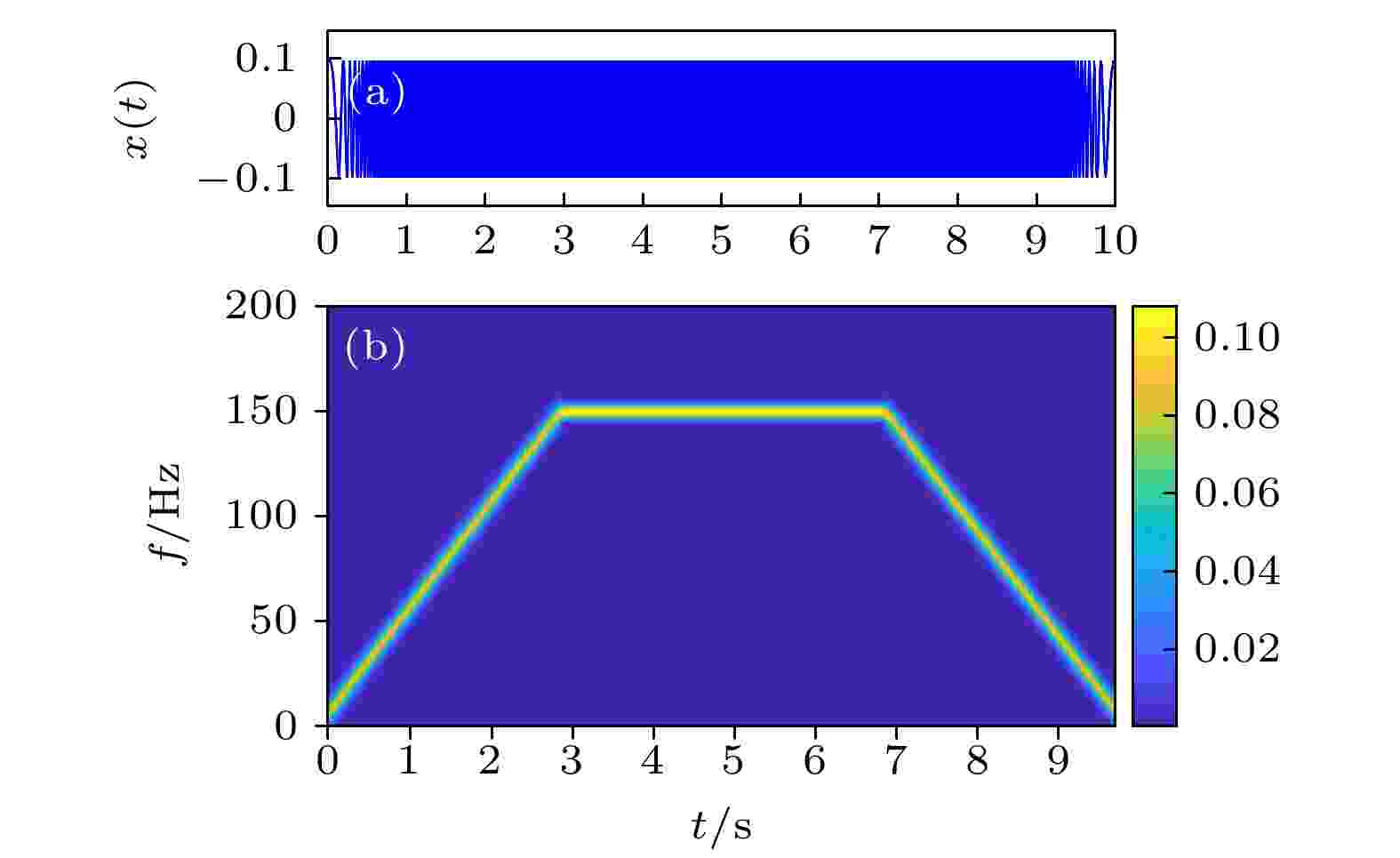
EDITOR'S SUGGESTION
2022, 71 (5): 050503.
doi:10.7498/aps.71.20211959
Abstract +
Nonlinear frequency modulation (NLFM) signal is widely used in radar, communication and signal processing. The response of nonlinear system excited by this kind of signal has rich information. At the same time, enhancing different types of signals by resonance phenomenon has unique advantages in the field of signal processing. Compared with other signal processing methods, such as empirical mode decomposition, variational mode decomposition, wavelet transform, signal filtering, etc., this kind of method can not only enhance the signal, but also effectively suppress the interference noise. Therefore, it has certain significance to study the nonlinear system optimal response excited by different NLFM signals and enhance the NLFM signal through resonance phenomenon. In this paper, what is mainly studied is the nonlinear system resonance phenomenon excited by different NLFM signals, which is different from in previous studies. Firstly, a real-time scale transformation method is proposed to process the NLFM signals, and its basic principle is to match different NLFM signals by real-time scale coefficients and system parameters. The signal frequency at each time corresponds to the coefficients with different scales and system parameters, thereby realizing the optimal resonance response at each time. In order to describe the optimal resonance response excited by the NLFM signal more accurately, unlike the traditional spectral amplification factor, the real-time spectral amplification factor is introduced as an evaluation index. Then, the influence of system parameters on the optimal system resonance response is discussed, and the optimal resonance region is obtained, which means that the optimal resonance response can be achieved by selecting the parameters in a reasonable range. This method not only greatly enhances the signal characteristics, but also maintains the continuity of signal time-frequency characteristics. Finally, the real-time scale transformation method is compared with the general scale transformation method, showing the superiority of the proposed method in processing NLFM signal. The method and the results of this paper show some potential in dealing with complex NLFM, which provides a reference for NLFM signal enhancement and detection, and has a certain practical significance in signal enhancement. Furthermore, the relevant influence law of the system optimal response excited by the NLFM signal is given, which has a certain reference value for studying the system dynamic behavior under different signal excitations.
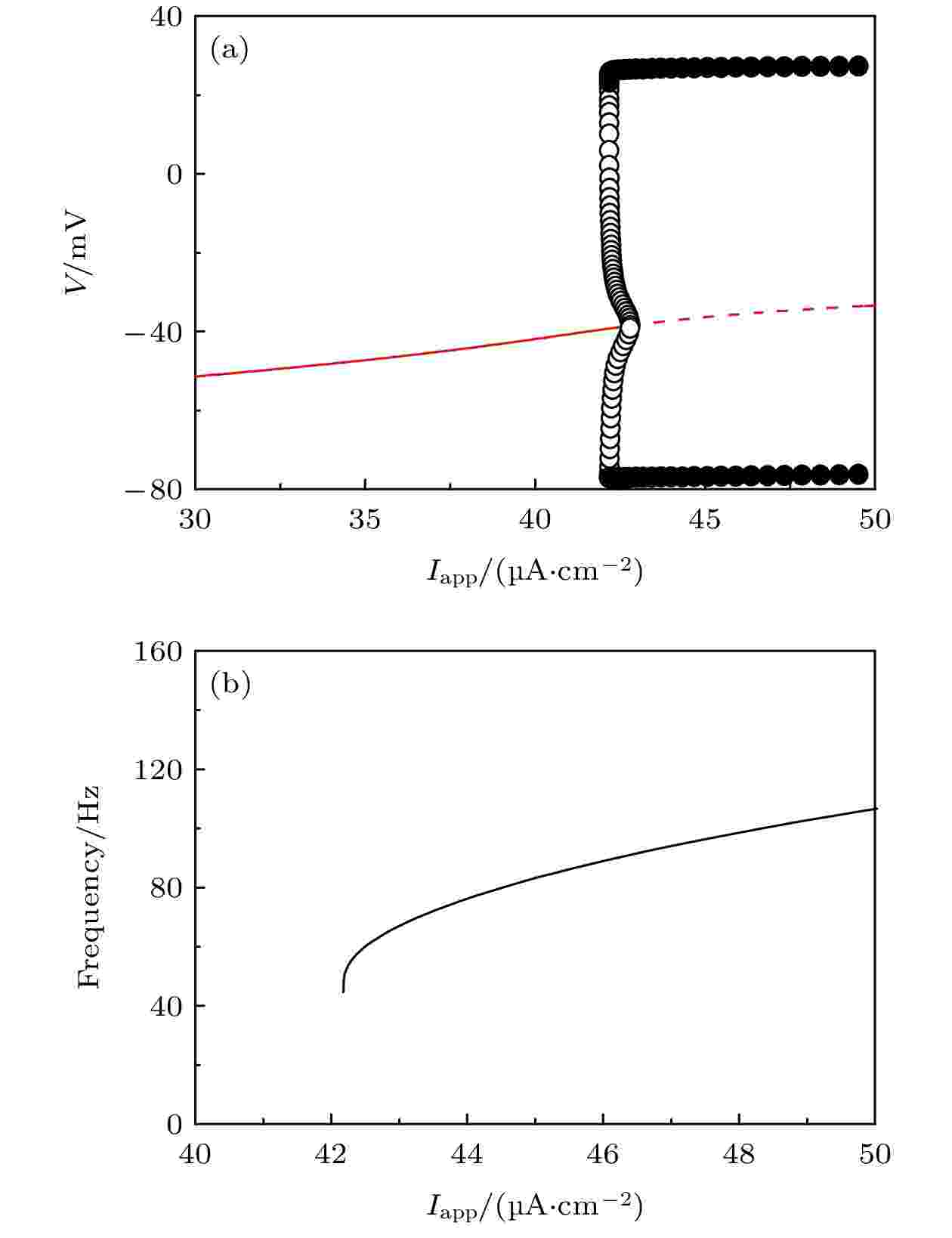
2022, 71 (5): 050504.
doi:10.7498/aps.71.20211829
Abstract +
Neural activities driven by synaptic inputs are important for neural coding. In general, excitatory synaptic inputs facilitate the firing activities of neurons, and inhibitory synaptic inputs suppress the firing activities. In the present work, the autapse model with adjustable current decay speed is considered, and the suppression effects of excitatory autapse on neuronal firing responses are simulated near subcritical Hopf bifurcation in the Morris-Lecar (ML) neuron model, which are compared with the suppression effects of the inhibitory autapse. Furthermore, the dynamical mechanisms of the suppression effects are acquired with the help of the phase response curve and phase trajectories perturbed by excitatory autaptic current. Near the subcritical Hopf bifurcation, the ML neuron exhibits monostable periodic spiking and coexistence of periodic spiking and resting state. For monostable periodic spiking, excitatory autaptic current with fast and middle decay speeds can induce the periodic spiking with reduced firing frequency and the mixed-mode oscillations (MMOs) that are alternations between subthreshold oscillations and a spike, respectively, and inhibitory autaptic current with middle and slow decay speeds can also induce these two behaviors, respectively. For the periodic spiking in the coexistence region, besides the above two behaviors, excitatory autaptic current with middle decay speed and inhibitory autaptic current with slow decay speed can induce the change from spiking to resting state. The results enrich the paradoxical cases that excitatory inputs suppress the neuronal firing responses, and present the different nonlinear mechanisms in the suppression effects of excitatory and inhibitory self-feedbacks on the neuronal spiking, which provide novel measures to modulate neuronal firing activity.
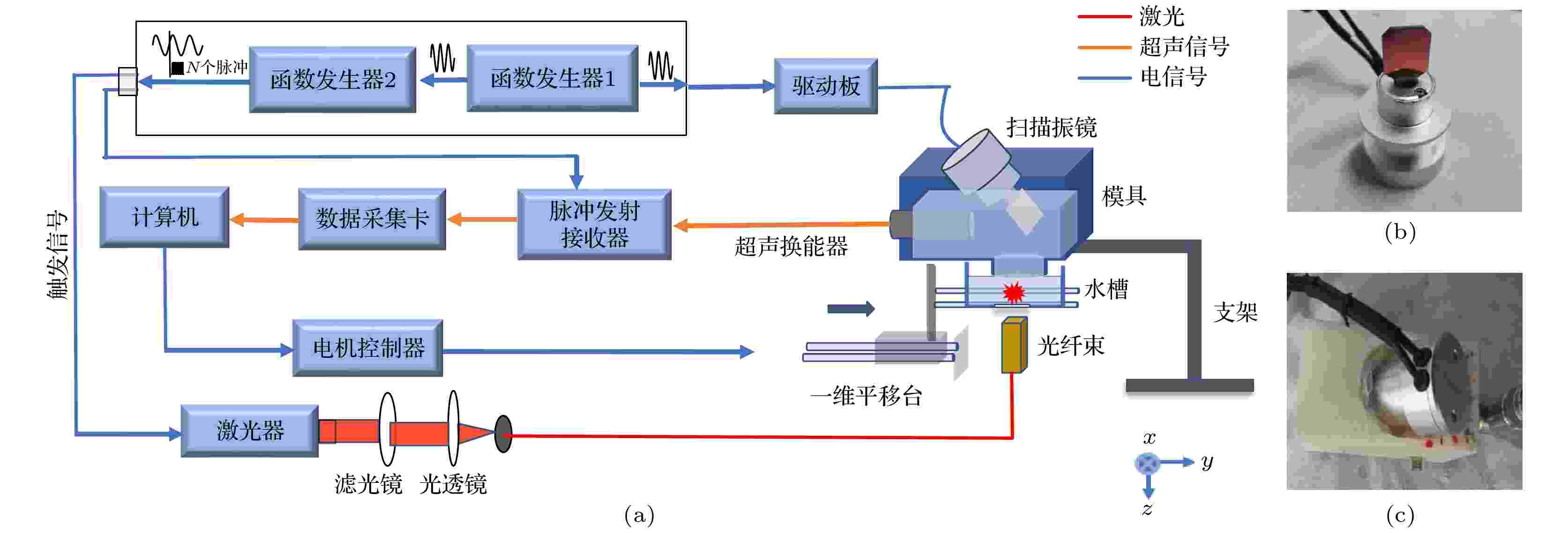
2022, 71 (5): 050701.
doi:10.7498/aps.71.20211394
Abstract +
Ultrasound/photoacoustic dual-modality imaging technology has greatly promoted the clinical application and photoacoustic imaging technology because it integrates the advantages of high-resolution structural imaging of ultrasound and high-contrast functional imaging of photoacoustic imaging. Traditional ultrasound/photoacoustic dual-modality imaging is based mainly on the array probe used in ultrasound imaging to collect photoacoustic signals at the same time. The system has a compact structure and easy operation. However, this kind of equipment utilizes array probes and multi-channel data acquisition system, which makes it expensive. And the imaging quality can be affected by the difference in channel consistency. In this paper, an ultrasound/photoacoustic dual-modality imaging method based on an acoustic scanning galvanometer is proposed. In this system, a single ultrasonic transducer combined with a one-dimensional acoustic scanning galvanometer is used for fast acoustic beam scanning to realize ultrasound/photoacoustic dual-modality imaging. It is a compact, low-cost and fast dual-modality imaging technology. The experimental results show that the effective imaging range of the system is 15.6 mm, and the temporal resolution of ultrasound and photoacoustic imaging are 1.0 and 0.1 s–1(B scan), respectively (the temporal resolution of photoacoustic imaging is limited mainly by the laser repetition rate). Based on the proposed technology research, it is helpful to further promote the clinical transformation and popularization of ultrasound/photoacoustic dual-modality imaging. It also provides a low-cost, miniaturized and fast scheme for multimodal imaging technology which is based on ultrasound signal detection.
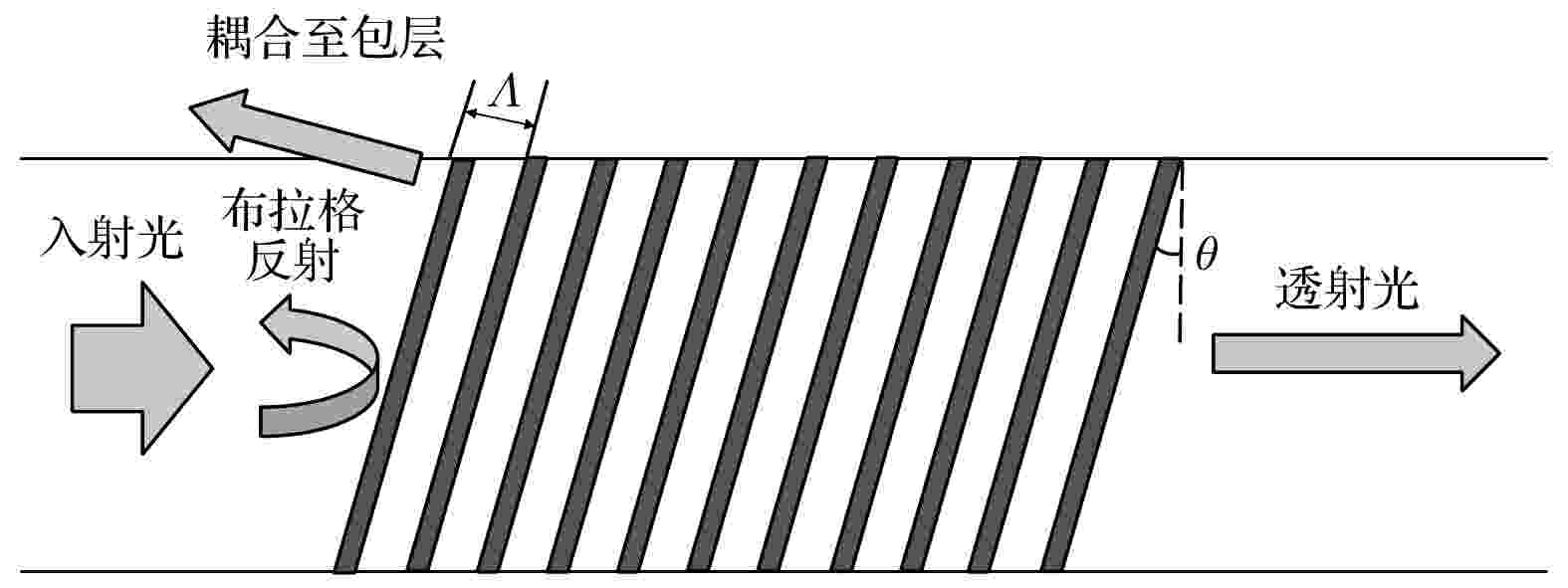
2022, 71 (5): 050702.
doi:10.7498/aps.71.20211315
Abstract +
Graphene oxide (GO) is an ideal label-free sensing material with its super large specific surface area and abundant surface functional groups. Considering its insulating characteristic, the GO is suitable for optics-based heavy metal ion sensing. However, given the large surface tension of water and the hydrophilicity of GO, the agglomeration or wrinkles of GO nanosheets is usually inevitable during coating with aqueous dispersion. This reduces the accessible surface area and surface functional groups of GO, thereby degrading the sensing performance. Here, an ultra-sensitive GO functionalized tilted fiber Bragg grating (TFBG) sensor is designed to detect heavy metal ions in aqueous solutions. Firstly, a strategy of free energy manipulation is employed to avoid the wrinkles and agglomeration of GO nanosheets. In the scenario of aqueous dispersion, the GO nanosheets will wrinkle as the water droplets evaporate and shrink. In contrast, using the lower-surface-tension ethanol as the dispersant and a high-surface-energy substrate processed by oxygen plasma, the dispersion will evenly spread on the substrate instead of forming droplets. When ethanol evaporates, GO nanosheets are attached to the substrate in largest possible area to reduce the free energy of the system, by which a GO film without agglomeration or wrinkles can be obtained. Secondly, the intrinsic sensitivity of TFBG is conducive to the detection of heavy metal ions in water. Mode interference occurs between the cladding mode and the core mode in the TFBG, and the wavelength and intensity of the interference are highly sensitive to the surrounding temperature, stress, and refractive index. Combining the above characteristics, the GO functionalized TFBG is highly sensitive to Pb2+, Cd2+, and Cu2+ions in water. These heavy metal ions are adsorbed by the GO, and thus causing the effective refractive index to increase. The results show that the adsorption of heavy metal ions makes the interference peaks red-shifted in the transmission spectrum. The lowest detection limit for Pb2+and Cd2+can reach 10–10mol/L (ng/L level), and the corresponding sensitivities are 0.426 and 0.385 dB/(nmol·L–1) (2.06 and 3.43 dB/(μg·L–1)), respectively. These superior sensing performances benefit from the high specific surface area and accessible carbonyl groups of the unfolded GO, and also rely on the excellent intrinsic sensitivity of TFBG. The GO functionalized TFBG sensor has a promising potential application in environment monitoring.
THE PHYSICS OF ELEMENTARY PARTICLES AND FIELDS
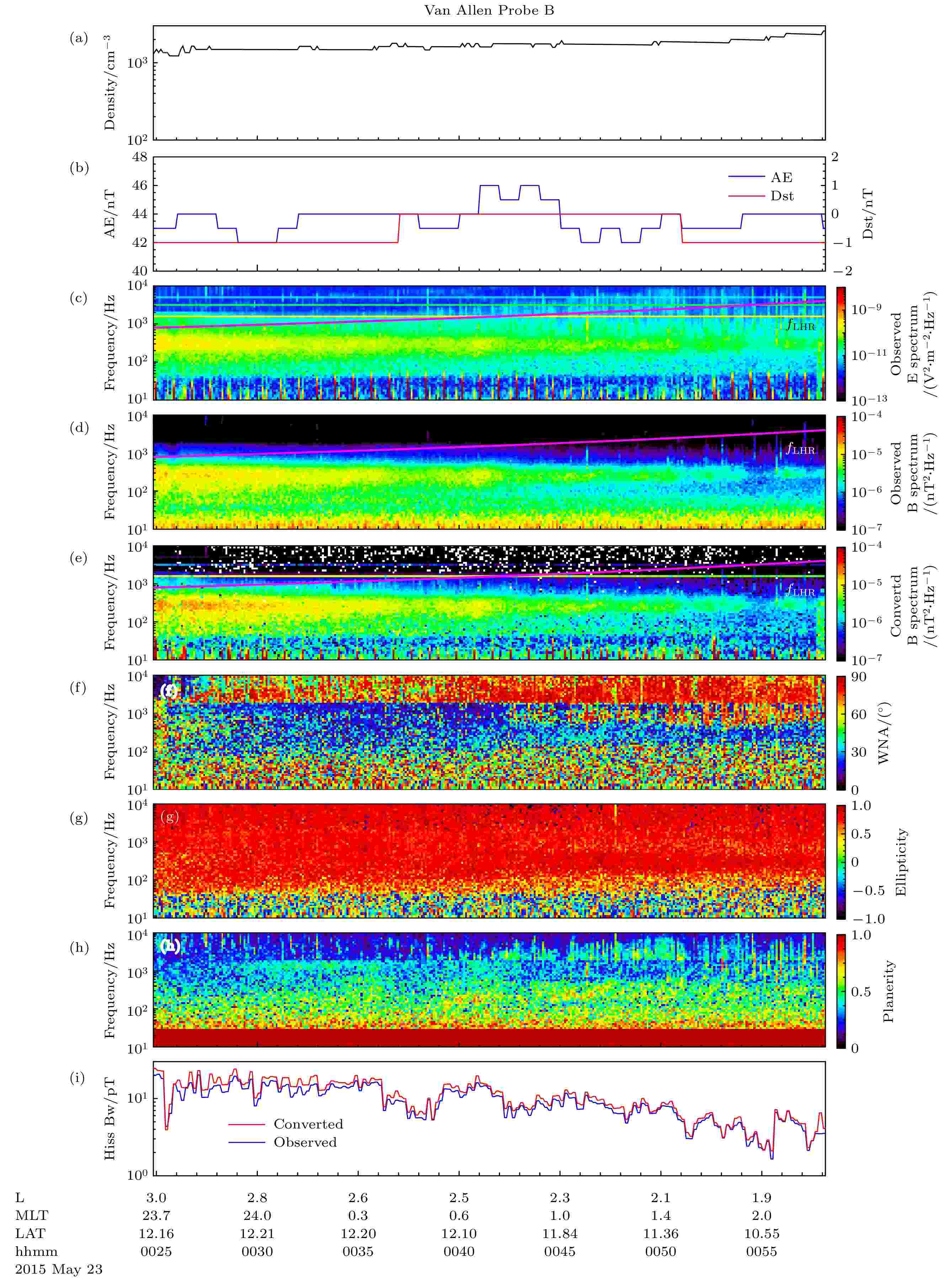
EDITOR'S SUGGESTION
2022, 71 (5): 051101.
doi:10.7498/aps.71.20211671
Abstract +
Electron scattering caused by plasmapheric hiss is the dominant mechanism that is responsible for the formation of slot region (1.8 ≤L≤ 3) between the Earth’s inner and outer radiation belts. The cold plasma dispersion relation of plasmaspheric hiss is widely used to quantify its scattering effect on energetic electrons. However, the existence of hot plasmas in the realistic magnetospheric environment will modify the dispersion properties of plasmaspheric hiss. According to Van Allen Probes observations, we select all hiss events in the slot region and compare the observed hiss wave amplitudes with the converted hiss wave amplitudes deduced from cold plasma dispersion relation and electric field observations, and then study the dependence of the applicability of cold plasma dispersion relation of slot region hiss on spatial position and geomagnetic activity. The results show that the cold plasma approximation tends to overestimate the amplitude of slot region hiss. The difference between the observed amplitude and the converted hiss wave amplitude has a strong day night asymmetry. However, it shows a slight dependence on the level of geomagnetic activities. In addition, we find that the converted wave magnetic field intensity is significantly lower (higher) than the observed magnetic field intensity at lower frequencies (higher frequencies), which indicates that the cold plasma approximation generally overestimates (underestimates) the scattering effects of hiss waves on the lower (higher) energy electrons in the slot region. Our study confirms that the application scope of the cold plasma dispersion relation of slot hiss has strong spatial and frequency limitations, which is of great importance in deepening our understanding of the dynamic evolution of electrons in the slot region.
NUCLEAR PHYSICS

2022, 71 (5): 052101.
doi:10.7498/aps.71.20211611
Abstract +
Surface discharge is one of the reasons for insulation failure. Polyimide (PI) is used in gas-solid insulation of high-frequency electric power equipment. Therefore, based on density functional theory, the effects of single molecular chain structure, energy level, density of states, electrostatic potential, excited state and other micro parameters under external electric field on trap formation and surface discharge of both PI and polar- group- OH–affected PI are discussed from the atomic and molecular level. The results show that the structure of PI is crimped and the dipole moment increases under external electric field, which is easy to accumulate charges to form space charge center, especially after the introduction of polar group OH–. In the PI molecules, hole traps are formed in the benzene ring region, and electron traps are formed in the imide ring region. The number of electron trap energy levels is large, in which the space charge trap depth gradually deepens with the increase of external electric field. After the introduction of polar group OH–, the excitation energy of PI molecules decreases, which makes the electrons inside the molecules excited easily. The spatial separation of electrons and holes decreases with the increase of electric field, which is conducive to the recombination of holes and electrons to emit photons.

COVER ARTICLE
2022, 71 (5): 052901.
doi:10.7498/aps.71.20211646
Abstract +
Lithium is one of the main materials of fuel carrier salt in molten salt reactors. Its neutron cross section provides an important basic datum for physical design of molten salt reactor core and for evaluating the safety of the core during operation. The total neutron cross sections of natural lithium samples with thickness values of 8.00 mm and 15.0 mm are measured, respectively, in an energy range from 0.4 eV to 20 MeV by using a neutron total cross section spectrometer (NTOX) with the transmission method at the Back-n white neutron source of China Spallation Neutron Source (CSNS Back-n) with a 76.0 m time-of-flight path. High quality experimental data are obtained, especially in the energy region of keV and below, which supply a significative supplement of the data, thereby providing more abundant and reliable experimental data for nuclear data evaluation of lithium. Additionally, a theoretical analysis is carried out under the guidance of 1/vlaw and the multilevel R-matrix theory. And the resonance parameters of n+6,7Li reaction around the energy of 260 keV are extracted from the measured data.
ELECTROMAGNETISM, OPTICS, ACOUSTICS, HEAT TRANSFER, CLASSICAL MECHANICS, AND FLUID DYNAMICS
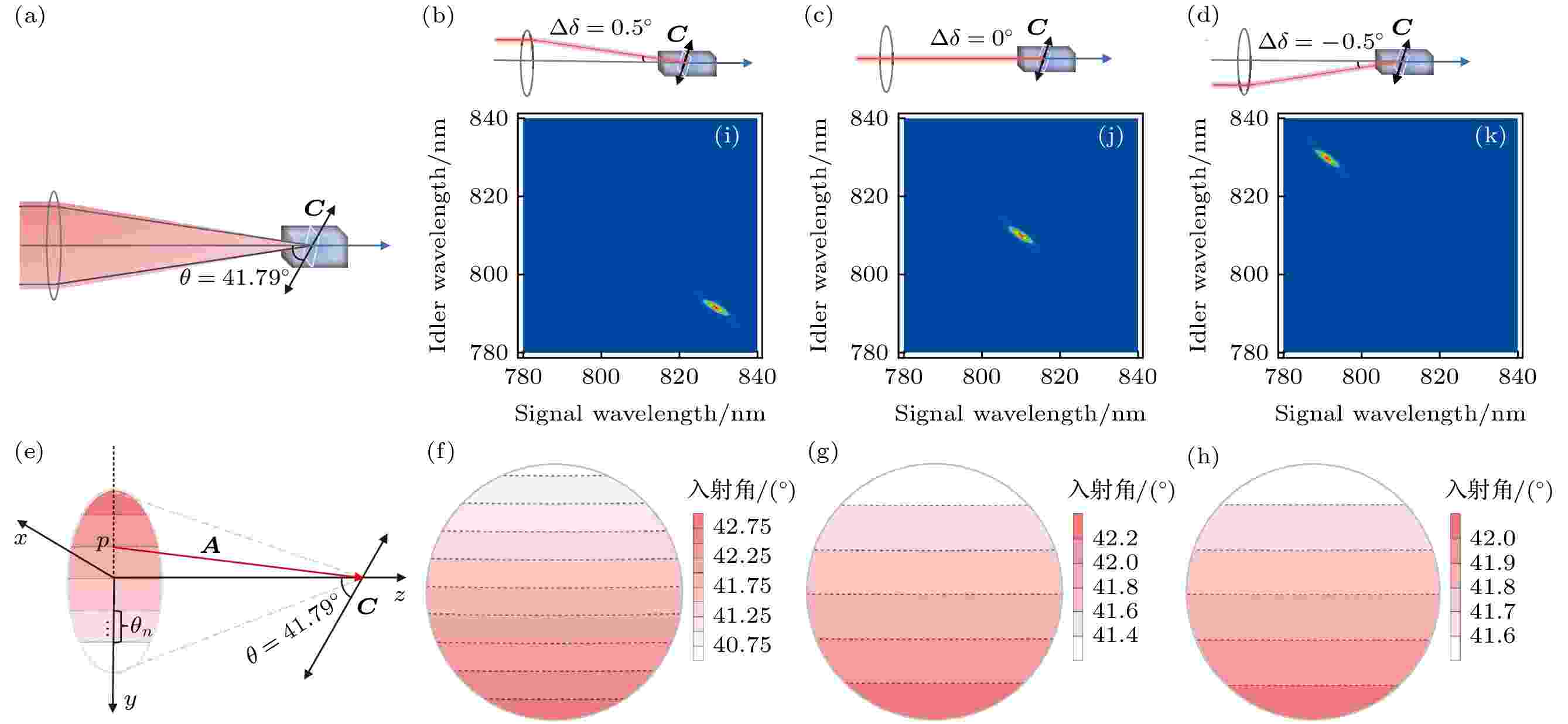
2022, 71 (5): 054201.
doi:10.7498/aps.71.20211783
Abstract +
Hong-Ou-Mandel (HOM) interference is a non-classical effect of photons and plays an important role in quantum optics. Theβ-barium borate (BBO) has a high nonlinear efficiency, and is commonly used to generate biphoton states, thereby exhibiting HOM interference. However, in previous experiments, researchers often used band-pass filters, so the resulting spectrum was directly determined by the band-pass filter. As a result, the original spectrum of the BBO crystal, especially the spectrum under tight focusing, was lack of systematic research. In this paper, the biphoton spectral distribution and HOM interference generated by the BBO crystal under the condition of tight focusing are systematically studied for the first time. Theoretical calculations show that using a lens with 50-mm focusing length, the spectral width of the down-converted photons is increased by 7.9 times that of the non-focused case; the width of the HOM interference fringe is reduced to 1/8, and the visibility of the interference fringe increases from 53.0% to 98.7%. We experimentally prepare the energy-time entanglement state by using type-II BBO crystal and perform HOM interference, thereby obtaining the interference visibility of
$(86.6 \pm 1.0)$
%. The increasing of the HOM visibility is due to the improvement of biphoton's spectral symmetry. In addition, the proposed technique by which different spectral distributions are obtained at different incident angles is expected to be applied to the preparation of high-dimensional qudits in the future.
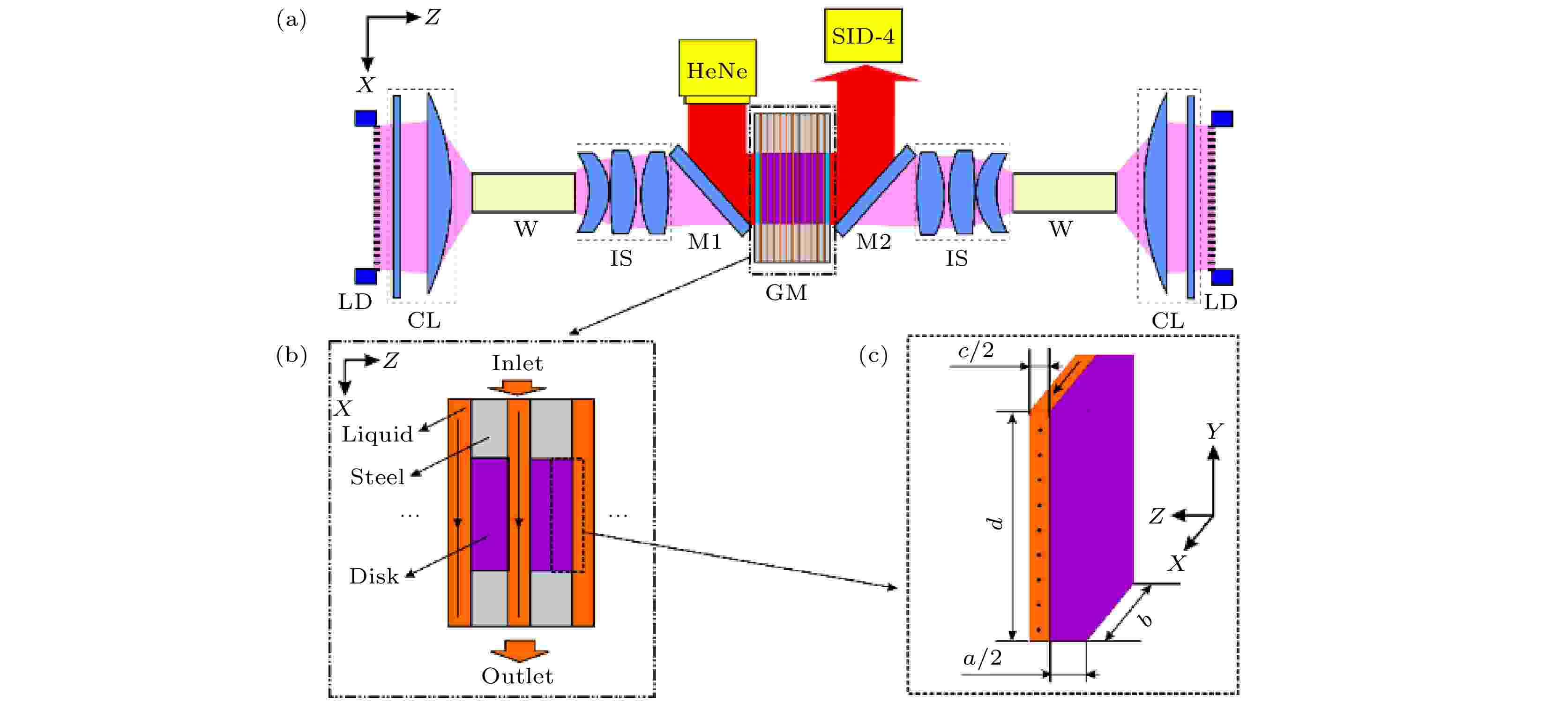
2022, 71 (5): 054202.
doi:10.7498/aps.71.20211811
Abstract +
In recent years, the direct-liquid-cooled thin-disk lasers have become ahot research topic due to their advantages of extremely small volume to output power ratio and strong thermal management ability. A method of analyzing the wavefront aberration of the direct-liquid-cooled thin-disk laser is established in this paper. The influence of pumping light uniformity on the wavefront aberration is investigated by this method. The high order aberration distribution of the laser beam is calculated, when the uniformity is 92%, 80% and 70%, respectively. With the decrease of beam uniformity, the higher order aberrationsincrease gradually, while the low order aberrations remain basically unchanged. Experimentally, the pumping beam distributions respectively with uniformity of 92% and 70% are designed with and without using the waveguide structure. The wavefront jitter and wavefront aberration distribution of the whole gain module are measured in these two cases. The pump power is kept at 5 kW. The higher order of optical path difference (OPDH) values of the whole gain module are measured to be 0.66 μm and 0.79 μm, respectively. The experimental results are in agreement with the theoretical analyses.
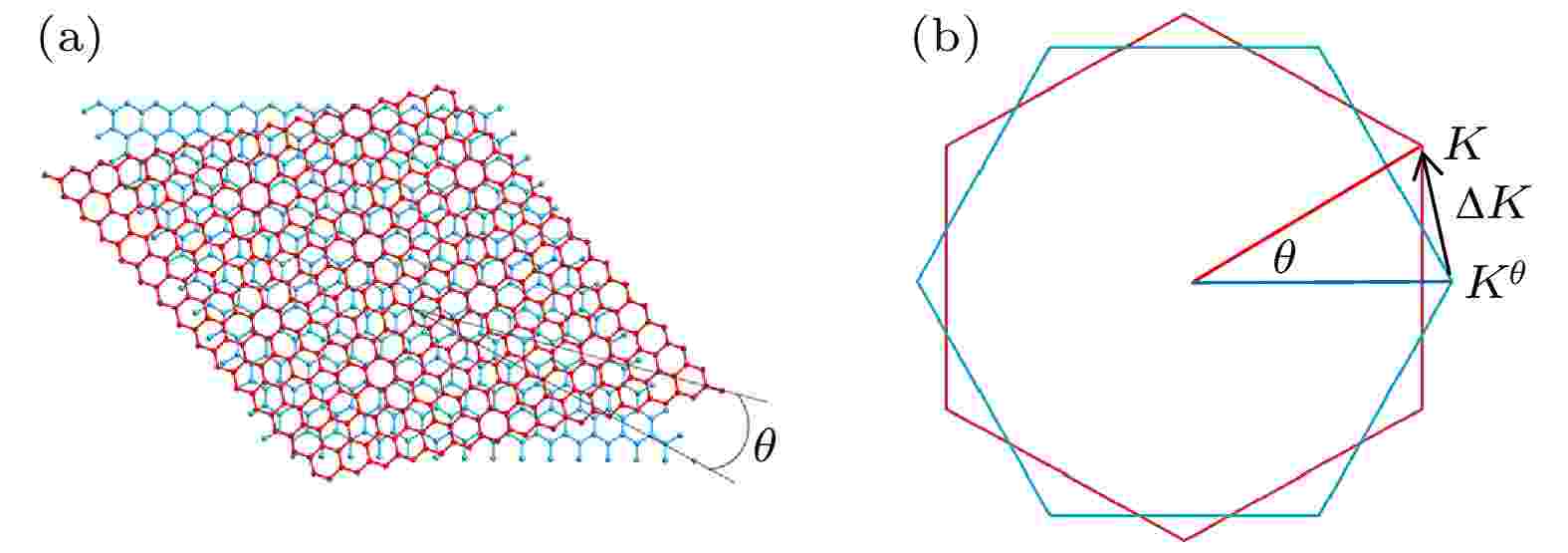
2022, 71 (5): 054203.
doi:10.7498/aps.71.20211406
Abstract +
The interlayer twist angle is an important parameter that can tune the physical properties of graphene in a wide wavelength range. In this paper, we employ an effective continuum model to calculate the band structure of twisted bilayer graphene with different twist angles in the presence and absence of vertical electric field. Based on the transition rate of the electron-photon interaction, we calculate and simulate the optical absorption spectra caused by the interband and intraband transitions around the van Hove singularities. The calculation results show that the optical absorption caused by the interband transitions occurs in the wavelength range from visible light to near-infrared while it appears in far-infrared for intraband transitions. The optical absorption coefficient of the intra-band transitions is almost two orders of magnitude larger than that of inter-band transitions. In the absence of an external electric field, as the twist angle increases, the absorption peak of the inter band transition moves from the infrared light band to the visible light band, but the resonant peak position of its intra-band transition does not change. At the same time, the absorption coefficient values corresponding to the above two transitions will increase. When an electric field is applied perpendicular to the twisted bilayer graphene, the symmetry of the initial band structure of bilayer graphene is destroyed, which results in the splitting of the absorption peaks associated the with interband transitions, and the distance between the two splitting peaks increases with the electric field intensity increasing; while the position and amplitude of the absorption peak associated with the intraband transition are completely unaffected by the applied electric field. The theoretical calculation results in this paper can provide the theoretical guidance for further applying twisted graphene to optoelectronic devices such as tunable dual-band filters.
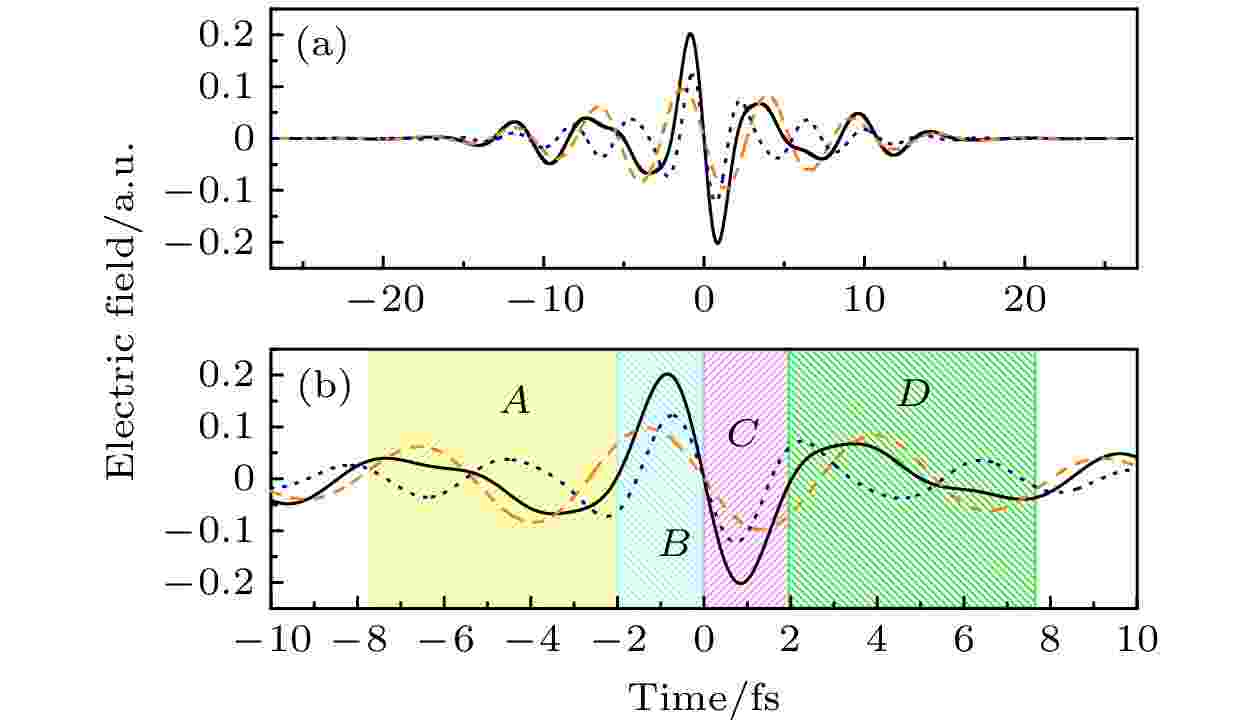
2022, 71 (5): 054204.
doi:10.7498/aps.71.20211502
Abstract +
Isolated attosecond pulses enables the studying and controlling of ultrafast electron processes in atoms and molecules. High-order harmonic generation (HHG) is the most promising way to generate such pulses, benefiting from the broad plateau structure of the typical HHG spectrum. We theoretically investigate high-order harmonic and attosecond pulse generation from helium atom in a three-color laser field, which is synthesized by 16 fs/1600 nm, 15 fs/1100 nm and 5 fs/800 nm pulse laser. Compared with harmonic spectrum generated by a two-color laser field synthesized by 16 fs/1600 nm and 15 fs/1100 nm, the harmonic spectrum generated from the synthesized three-color field exhibits high conversion efficiency and broadband supercontinuum characteristics. The continuous spectrum range covers from 230th to 690th harmonics, and the generation of 128 attosecond isolated short pulses with higher intensity is realized after Fourier transform. This result is attributable to the fact that the synthesized three-color electric field exhibits high-intensity and few-cycle mid-infrared femtosecond pulse laser characteristics, which can effectively control atomic ionization and recombination occurring within an effective optical period of the mid-infrared femtosecond pulse. This scheme solves the problems faced by the current femtosecond pulse laser technology, i.e. the few-cycle mid-infrared femtosecond pulse laser cannot have both carrier envelope phase stability and high power output.
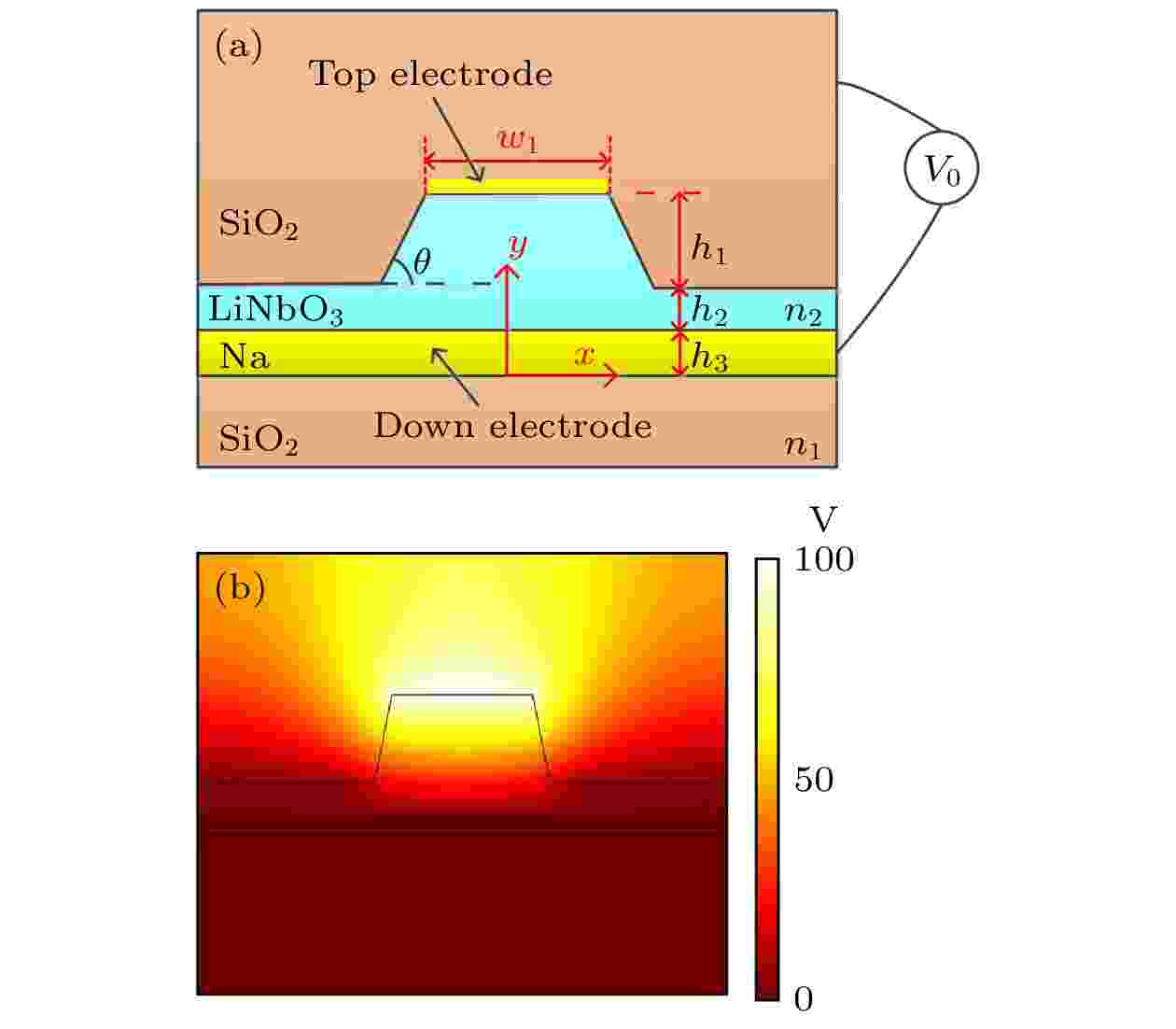
EDITOR'S SUGGESTION
2022, 71 (5): 054205.
doi:10.7498/aps.71.20211217
Abstract +
To meet the increasing demand of integrated photonic device design, a LiNbO3/Na surface plasmonic waveguide (LNSPW) is demonstrated, and a directional coupler (DC) based on the LNSPW is also studied. The mode characteristics of the LNSPW and the coupling performances of the DC are simulated by the finite element method (FEM). There are four modes in the LNSPW when its width (w1) and the thickness (h1) are less than 600 nm and 400 nm, respectively. The number of the modes in the LNSPW increases with waveguide size increasing. To achieve the single-mode propagation,w1andh1are chosen to be 300 nm and 200 nm, respectively. The effective refractive index (neff), propagation length (Lp), and normalized effective mode area (Aeff/A0) are analyzed with different dimensional parameters of the LNSPW. The value ofLpis ~200 μm, andAeff/A0is less than 0.4. In order to demonstrate the electro-optic tunable performance, the normalized output power (Pnorm) values of the DC are calculated based on the LNSPWs with different values of coupling interval (Wgap), coupling length (LC), and operating wavlength (λ). ThePnormvalues of the output ports (port 2 and port 3) vary withWgapandLC. Owing to the electro-optic effect of LiNbO3(LN),Pnormof the DC can be adjusted by changing the applied electrostatic voltage (V0). The influence ofV0onPnormincreases whenWgapis larger than 100 nm andLCis greater than 12 μm. The larger the value ofLCandWgap, the stronger the effect ofV0onPnormis, butPnormvalues from two output ports decrease withWgapandLCincreasing. A 3 dB coupler can be achieved by changingV0to 53 V whenWgap= ~100 nm,LC= ~17 μm, andλ= 1.55 μm, and has good directivity and isolation. The LNSPW provides a feasible scheme to realize the tunable DC, and has potential applications in integratable electro-optic tuanble devices, nonlinear optics, optical signal processing, and optical holographic storage.

2022, 71 (5): 054206.
doi:10.7498/aps.71.20211838
Abstract +
Complementary metal oxide semiconductor (CMOS) image sensor is susceptible to proton single event effect when being applied to space environment. Proton irradiation experiments with different energy values are carried out on a commercial FSI and BSI CMOS image sensors. The proton single event effect is analyzed by on-line testing, the maximum proton energy is 200 MeV, and the total fluence is 1010particle/cm2. The single-event transient bright spots of different shapes are observed in the pixel array. By extracting the deposition energy and size, the effects of different energy protons on transient bright spot characteristics are compared, and the transient bright spot characteristics between FSI and BSI are also compared. Finally, the energy deposition distribution of the transient bright spot generated by proton in CMOS image sensor pixel unit is predicted by comparing the simulation method with the experimental results. The simulation results verify that the decrease of PPD depletion region thickness and the thinning of epitaxial layer are the main factors leading the proton energy deposition distribution to shift leftward in BSI image sensor.
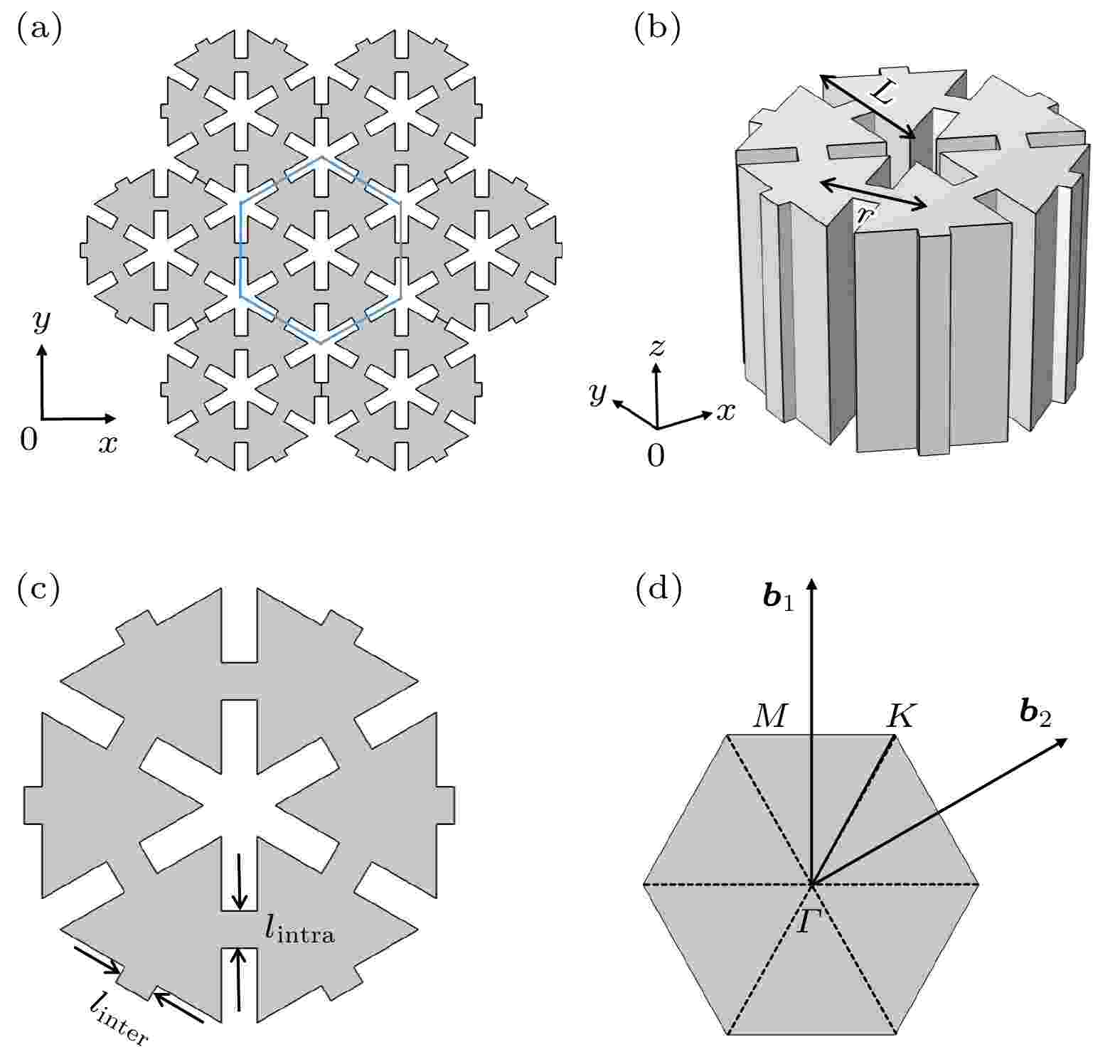
EDITOR'S SUGGESTION
2022, 71 (5): 054301.
doi:10.7498/aps.71.20211848
Abstract +
In recent years, a new type of topological insulator, termed higher-order topological insulator, has attracted tremendous research interest. Such exotic lower-dimensional topological boundary states have been extended and reproduced in classical systems, such as optics and acoustics. In this paper, a two-dimensional acoustic honeycomb structure with a triangle resonant cavity is numerically studied. Topological phase transition is induced by gradually adjusting the intracell and intercell coupling, and then the topological phase is used to construct a second-order topological insulator. The topological properties of second-order topological insulators can be characterized by using the quantized quadrupole moments. When quantized quadrupole
$ {Q_{ij}} = 0 $
, the system is trivial, while
$ {Q_{ij}} = 1/2 $
, the system is topologically nontrivial. We investigate the acoustical higher-order states of triangular and hexagonal structures, respectively. The gapped zero-dimensional corner states are observed in both structures, but the robustness properties of the corner states emerge only in the hexagonal structures but not in the triangular-shaped ones. The topological corner modes will offer a new way to robustly confine the sound in a compact acoustic system.
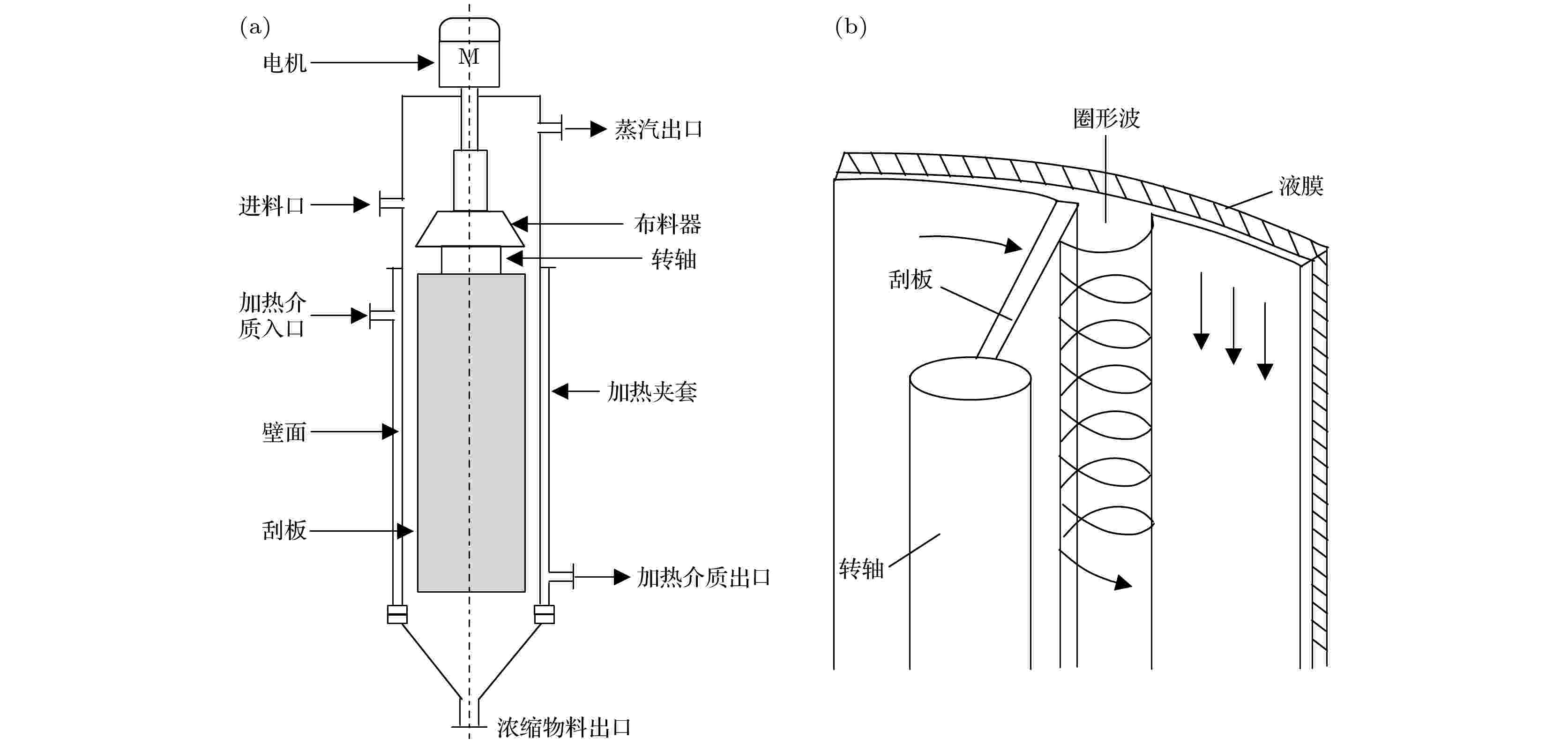
2022, 71 (5): 054701.
doi:10.7498/aps.71.20211921
Abstract +
Agitated thin film evaporator (ATFE) is a new type of high-efficiency evaporator where a film is forced to form through a rotating scraper and the high-viscosity non-Newtonian flow materials can be evaporated smoothly. The flow distribution and transmission mechanism of the material in the evaporator directly determine the evaporation efficiency and power consumption of the evaporator. Unlike previous study that was based mainly on Newtonian flow, this paper establishes a three-dimensional computational fluid dynamics model of ATFE for non-Newtonian flow with different viscosities, and systematically probes the flow field distribution characteristics and film forming mechanism in the evaporator. The results show that the flow field distribution characteristics of low-viscosity non-Newtonian flow are similar to those of Newtonian flow, the material can form a uniform and continuous liquid film on the wall; as the viscosity increases, the uniformity and continuity of the liquid film gradually deteriorate. Through studying the flow field distribution and transmission form of the materials, and combining the liquid film distribution, velocity distribution, shear strain rate distribution, and viscosity distribution, it is found that the shear field and viscosity distribution formed by the internal structure and operating state of the evaporator are the key to the good film formation. In addition, it is proposed that the bending of the leading edge of the scraper can assist the spreading of high viscous fluid liquid film, and the best bending angle is explored. This research provides theoretical guidance and basis for the design and application of ATFE.
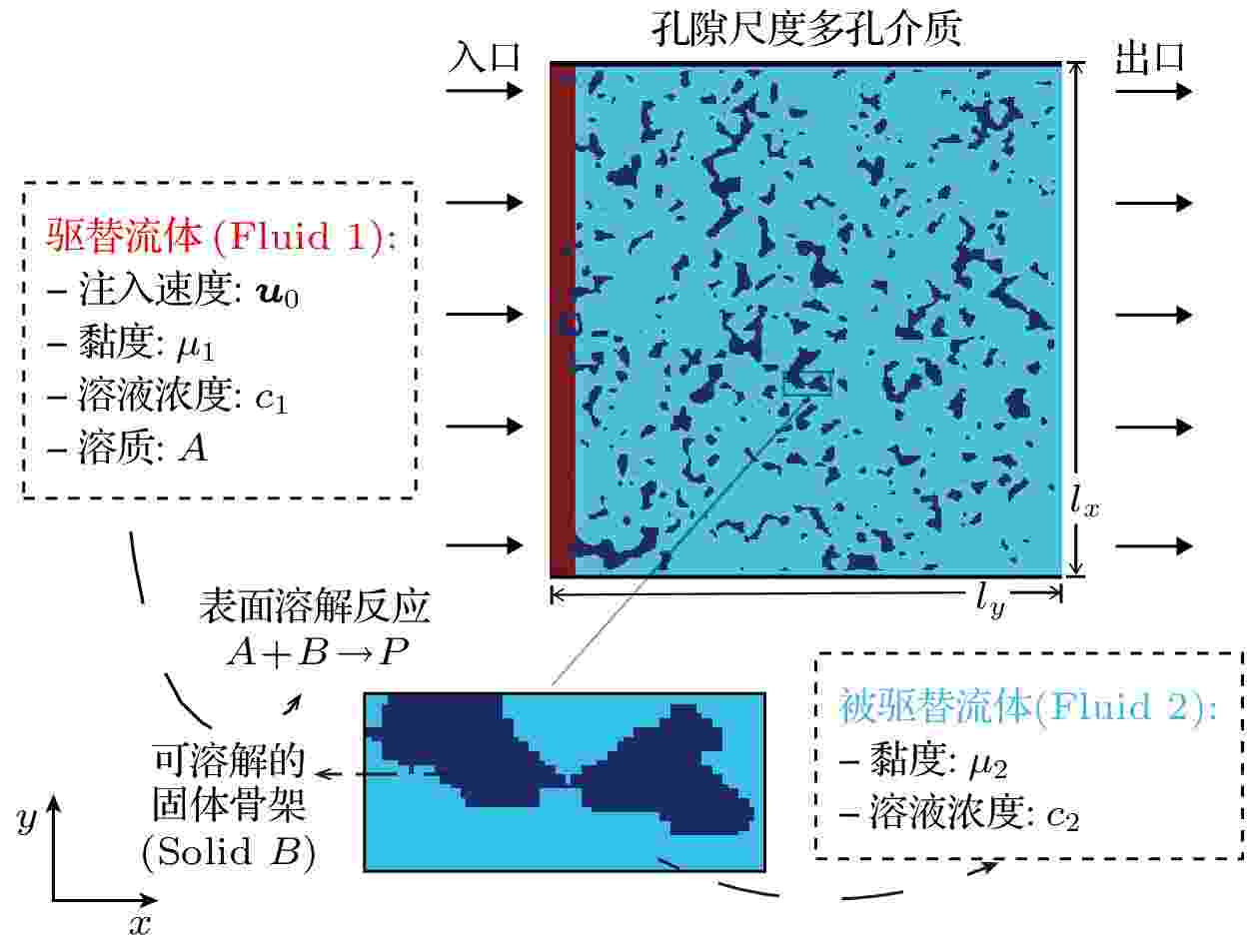
2022, 71 (5): 054702.
doi:10.7498/aps.71.20211851
Abstract +
The miscible displacement with fluid-solid dissolution reaction in a porous medium is a typical process in many industrial applications, such as underground-water pollution decontamination, and oil recovery or geological sequestration of carbon dioxide. It is a significant problem in engineering and physics applications. As is well known, the dissolution reaction can change the structure of the porous medium, which will have a great influence on the miscible displacement process. However, the relationship between the displacement process and the dissolution reaction in a porous medium has not been fully studied. In this study, the miscible displacement with dissolution in a porous medium is simulated by a lattice Boltzmann method (LBM). The study focuses on the influence of the internal structure change on the displacement process, and the further quantitative analyzing of the changes of the porosity and displacement efficiency by changing the Damkohler number (Da) and the Pèlcet number (Pe). The results show that whenDais large enough, the dissolution reaction will generate a few wormholes in the porous medium, and the displacement fluid will leave the porous medium along the wormholes, resulting in the decrease of the displacement efficiency. AsDaincreases, the reaction goes faster, the rate of change in porosity increases, and the wormholes become wider, thereby indeed yielding a larger displacement efficiency. With the increase ofPe, the fingerings develop faster, the rate of change in porosity decreases, and the displacement efficiency decreases as well.
PHYSICS OF GASES, PLASMAS, AND ELECTRIC DISCHARGES

2022, 71 (5): 055201.
doi:10.7498/aps.71.20211524
Abstract +
The surface of metal system exposed to ionizing radiation (X-ray and γ-ray) will emit high-energy electrons through the photoelectric effect and other processes. The transient electromagnetic field generated by the high-speed electron flow is called system generated electromagnetic pulse (SGEMP), which is difficult to shield effectively. An ongoing effort has been made to investigate the SGEMP response in vacuum by numerical simulation. However, the systems are usually operated in a gaseous environment. The objective of this paper is to investigate the effect of low-pressure air on the SGEMP. A three-dimensional hybrid simulation model is developed to calculate the characteristics of the electron beam induced air plasma and its interaction with the electromagnetic field. In the hybrid model, the high-energy photoelectrons are modelled as macroparticles, and secondary electrons are treaed as fluid for a balance between efficiency and accuracy. A cylindrical cavity with an inner diameter of 100 mm and a length of 50 mm is used. The photoelectrons are emitted from one end of the cavity and are assumed to be monoenergetic (20 keV). The photoelectron pulse follows a sine-squared distribution with a peak current density of 10 A/cm2, and its full width at half maximum is 2 ns. The results show that the number density of the secondary electrons near the photoelectron emission surface and its axial gradient increase as air pressure increases. The electron number density in the middle of the cavity shows a peak value at 20 Torr (1 Torr = 133 Pa). The electron temperature decreases monotonically with the increase in pressure. The low-pressure air plasma in the cavity prevents the space charge layer from being generated. The peak value of the electric field is an order of magnitude lower than that in vacuum, and the pulse width is also significantly reduced. The emission characteristic of the photoelectrons determines the peak value of the current response. The current reaching the end of the cavity surface first increases and then decreases with pressure increasing. The plasma return current can suppress the rising rate of the total current and extend the duration of current responses. Finally, to validate the established hybrid simulation model, the calculated magnetic field is compared with that from the benchmark experiments. This paper helps to achieve a better prediction of the SGEMP response in a gaseous environment. Compared with the particle-in-cell Monte Carlo collision method, the hybrid model adopted can greatly reduce the computational cost.
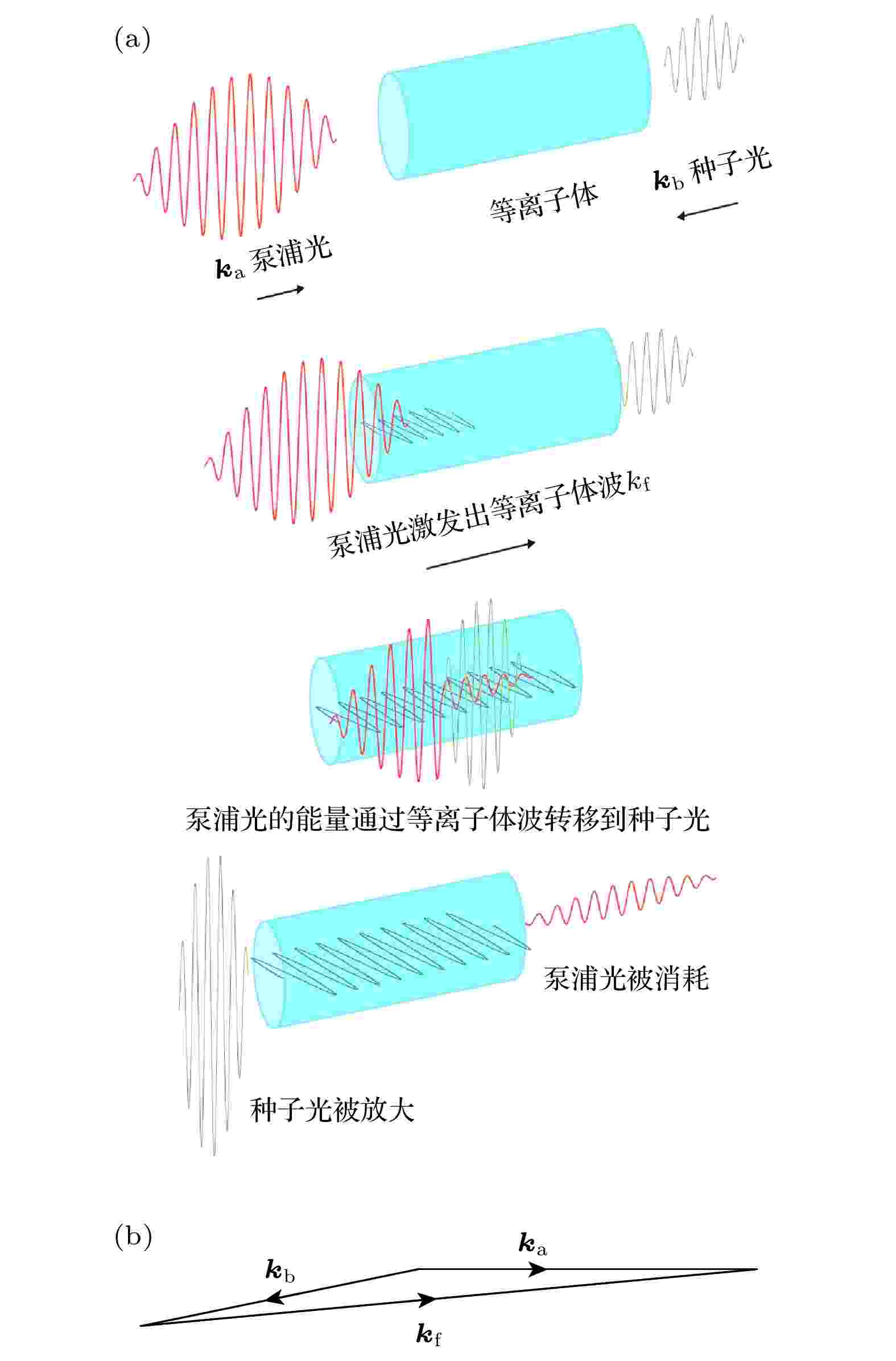
2022, 71 (5): 055202.
doi:10.7498/aps.71.20211270
Abstract +
The density, temperature and length of the plasma used in the backward Raman amplification will all influence the result. To explore the influence of the plasma density and the pump intensity, this work uses the one-dimensional particle in cell (PIC) algorithm to simulate the process of the 800 nm pump laser injecting into the plasma. By analyzing the Raman scattered light, it is found that as the density of plasma increases, the wavelengths of the scattered light shorten. It is also found that the forward Raman scattering will cause the plasma density to change, which in turn influences the scattered light wavelength. Therefore, we should choose the plasma density based on the wavelength of the pump and the scattered light, while the amplification of the scattered is related to the pump intensity.
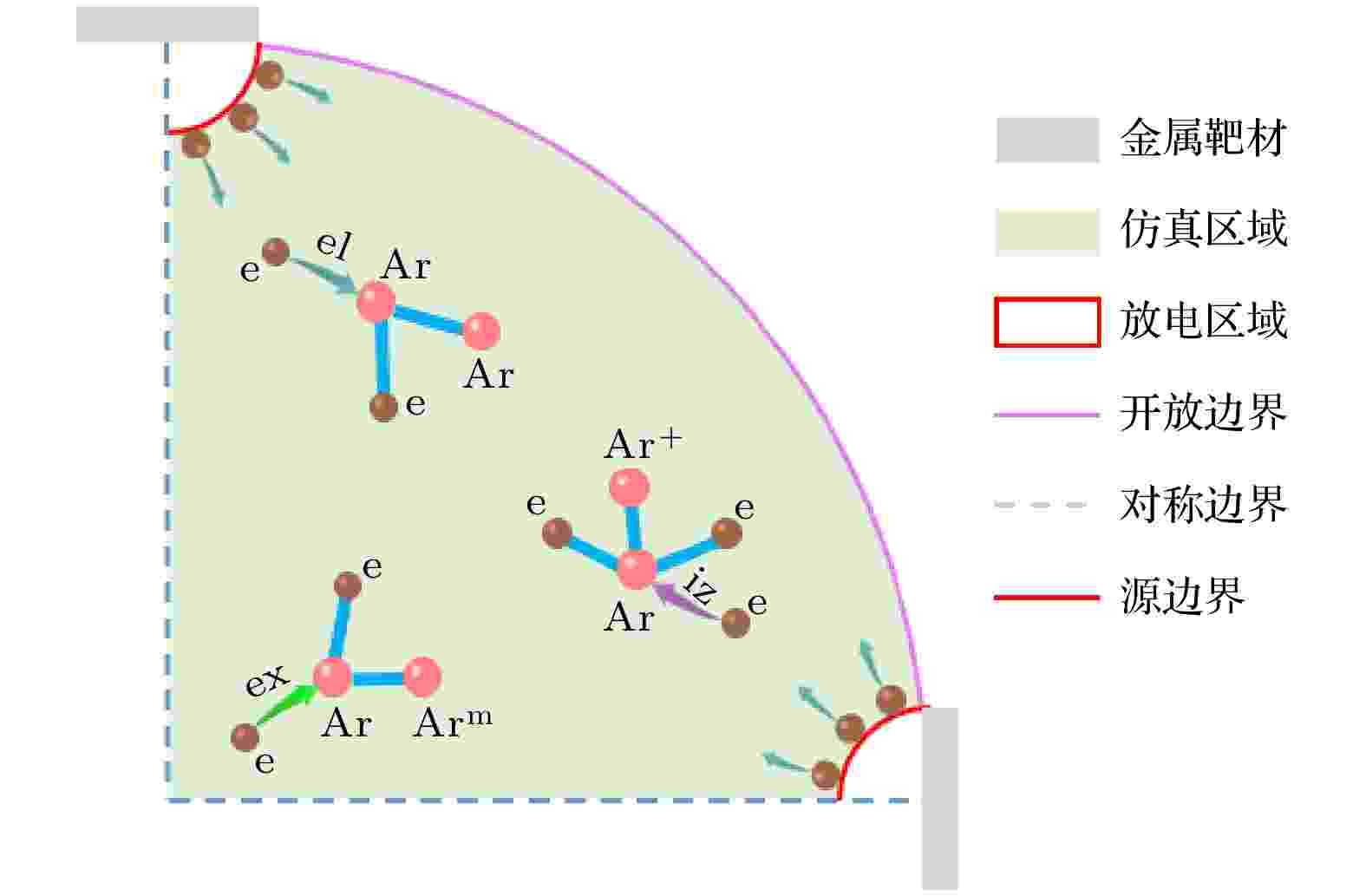
2022, 71 (5): 055203.
doi:10.7498/aps.71.20211781
Abstract +
Closed magnetic field constructed by unbalanced magnetron sputtering (MS) cathodes has been a general means of developing the MS coating system. However, owing to the difficulties in characterizing the complex plasma behaviors, there are still no quantitative criteria or design bases for some critical points, such as the effective object, the working mechanism, the closure condition, the layout logic and the effectivity of the closed magnetic field. Here in this work, out of the movements of charged particles in magnetic field, the motion behaviors of electrons and ions in the vacuum chamber are studied and it is also revealed that the closed magnetic field can affect mainly the electrons and further control the distributions of ions. A Monte-Carlo collision (MCC) model of the closed magnetic field MS coating system is established by test-electron to characterize the plasma transport characteristics, and the electron constraint and coating deposition efficiency are studied by different layouts of the magnetron cathodes and the ion sources. The simulation results show that the cathode numbers and vacuum chamber size determine the constraint effect on electrons in closed magnetic field. By 8 MS cathodes and the chamber radius of 0.5 m, the proportion of the overflow electrons can decrease to 1.77%. To increase the proportion of the electrons in the coating region, four coupled magnetic fields are introduced in the center of vacuum chamber. The studies of cathode type, rotation angle and magnetic field direction reveal that the proportion of the overflow electrons is less than 3%. A local dense plasma distribution and a continuous uniform plasma distribution can be observed in the vacuum chamber, corresponding to the same and opposite layout in magnetic poles of the MS cathodes and the ion sources, and the proportion of the electrons in the coating region significantly increases to 53.41% and 42.25%, respectively.
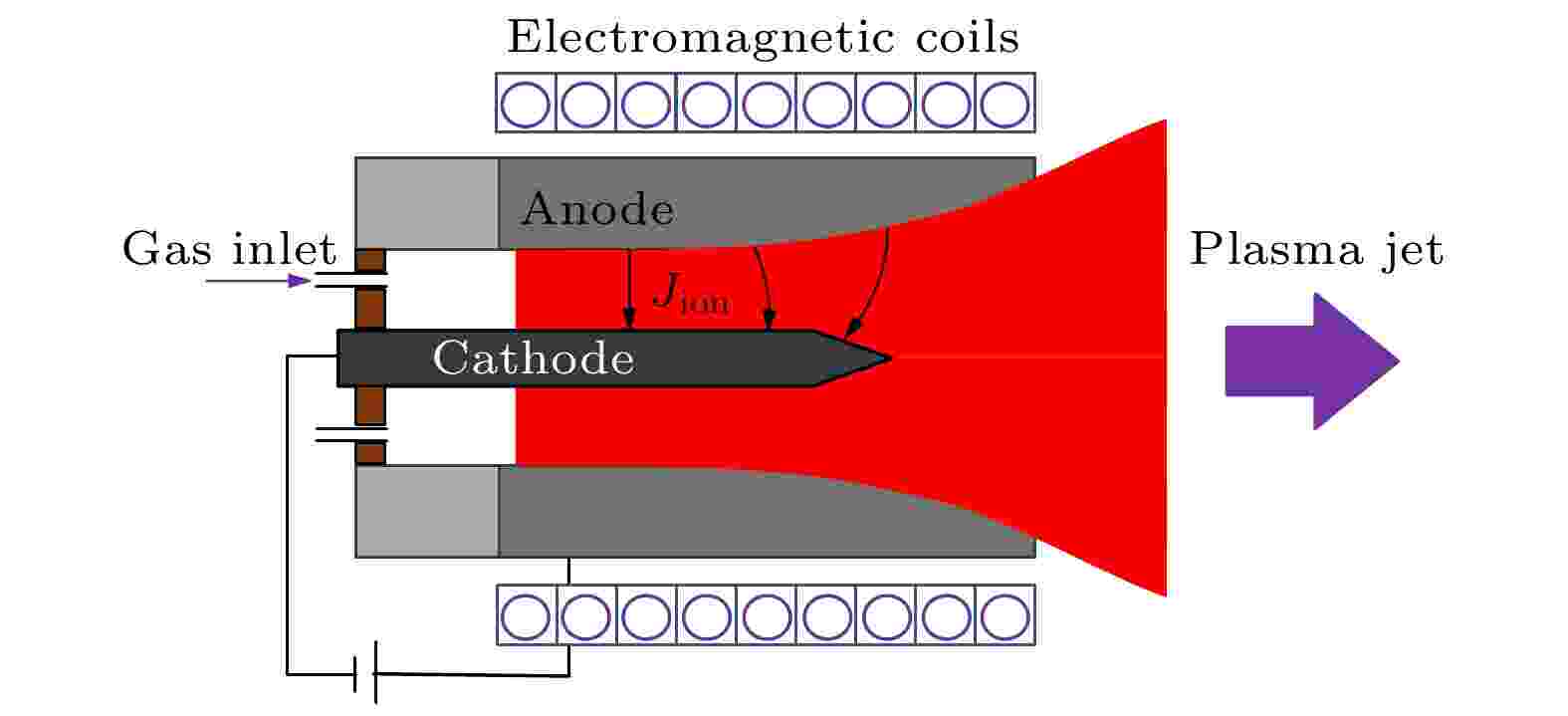
2022, 71 (5): 055204.
doi:10.7498/aps.71.20211383
Abstract +
The magnetoplasmadynamic thruster is a typical representative of the high-power electric propulsion device, and the magnetoplasmadynamics process is its core operating mechanism. In order to understand the influence of applied magnetic field on its operating characteristics, the particle-in-cell particle simulation method combined with the scale model based on the self-similarity criterion is used to simulate the operating process of magnetoplasmadynamic thruster with applied magnetic field. The reliability of the model and method are verified by comparing with the experimental results. The plasma characteristic parameter distribution of the thruster during ignition is analyzed, and the influence of external magnetic field and cathode current on the thruster performance are discussed. The research results show that the construction of the discharge arc between the cathode and anode is a key step for thruster ignition and efficient operation. A low-intensity magnetic field is not conducive to the construction of a stable discharge arc, while the plasma beam is concentrated near the axis and the main thrust generation mechanism is the self-field acceleration. The discharge arc between cathode and anode is stable by applying a high magnetic field, and the main mechanism of thrust generation is vortex acceleration, which causes the thrust and specific impulse to increase linearly with the strength of the external magnetic field. The efficiency of the thruster increases with cathode current and the applied magnetic field intensity increasing. The discharge voltage increases with the augment of cathode current, but first decreases and then increases with applied magnetic field intensity increasing.
CONDENSED MATTER: STRUCTURAL, MECHANICAL, AND THERMAL PROPERTIES
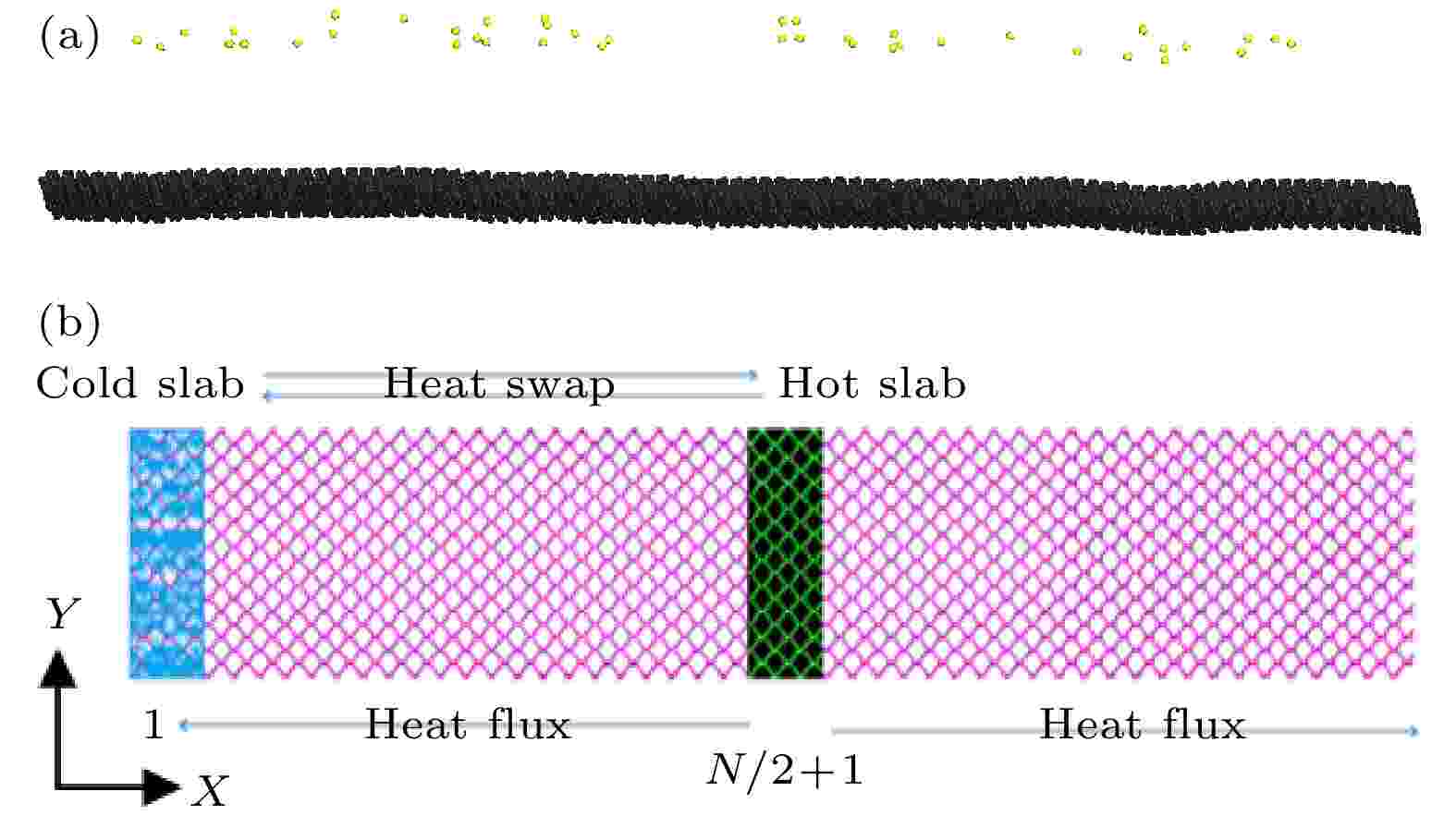
2022, 71 (5): 056101.
doi:10.7498/aps.71.20211857
Abstract +
Defects produced by ion irradiation can effectively modulate many physical properties of phosphorene. In this paper, the molecular dynamics method is used to simulate the ion irradiation process of phosphorene. The relations between the formation probability of defects and the energy of incident ions, ion species and incident angle of ions are revealed. The non-equilibrium molecular dynamics simulation is used to calculate the thermal conductivity of irradiated phosphorene. The effects of the energy of ions, the irradiation dose, the type of ions and the incident angle of ions on the thermal conductivity of phosphorene are systematically investigated. The influence of the vacancies on the phonon participation rate of phosphorene is studied by lattice dynamics method, and the spatial distribution of localized modes is demonstrated. According to the quantum-mechanical perturbation theory and bond relaxation theory, we point out that the dominant physical mechanism of vacancy defects which significantly reduce the thermal conductivity of phosphorene is the strong scattering of phonons by the low-coordinated atoms near the vacancies. This study provides a theoretical basis for tuning the heat transport properties of phosphorene by defect engineering.
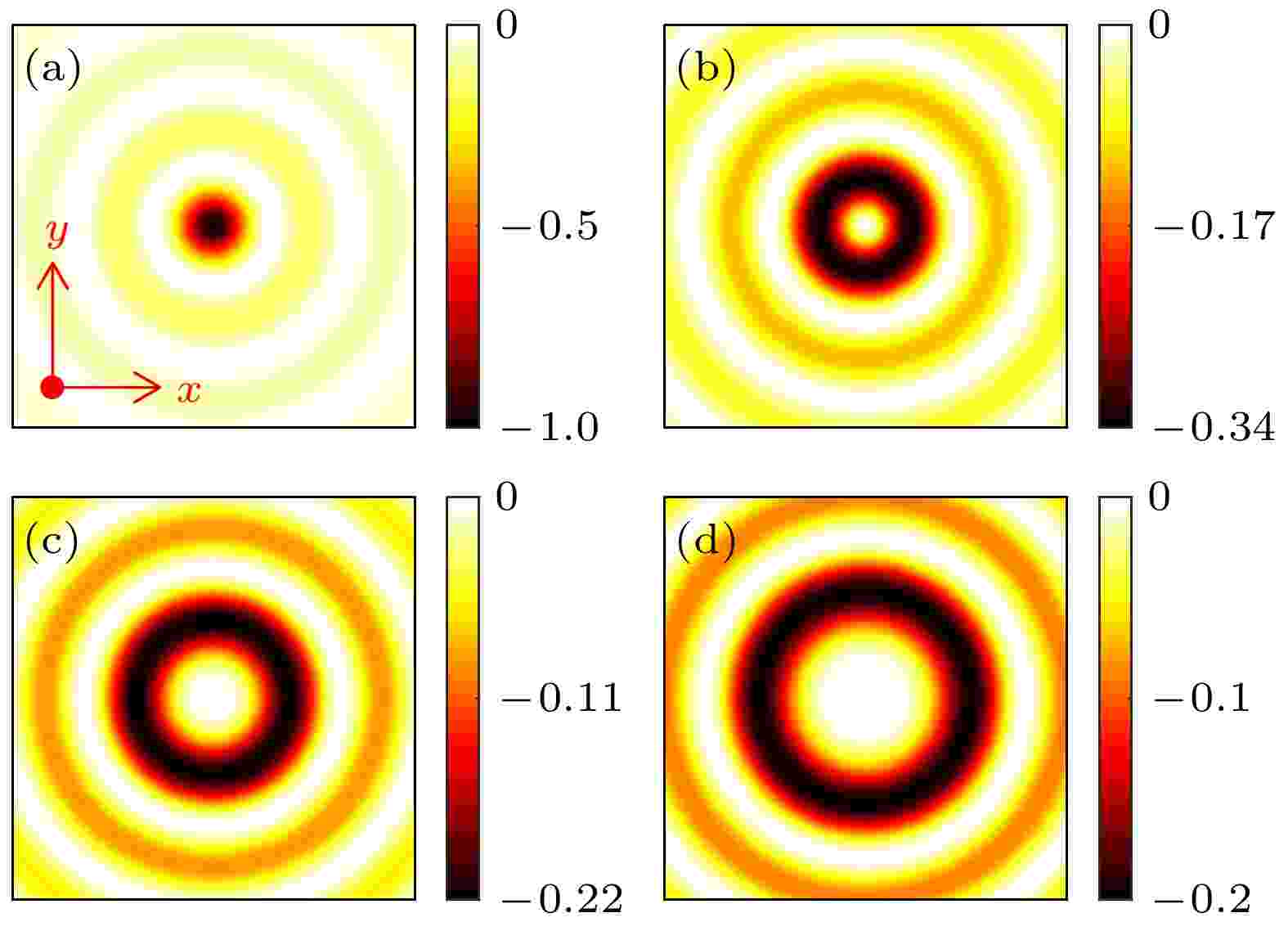
2022, 71 (5): 056701.
doi:10.7498/aps.71.20211949
Abstract +
CONDENSED MATTER: ELECTRONIC STRUCTURE, ELECTRICAL, MAGNETIC, AND OPTICAL PROPERTIES
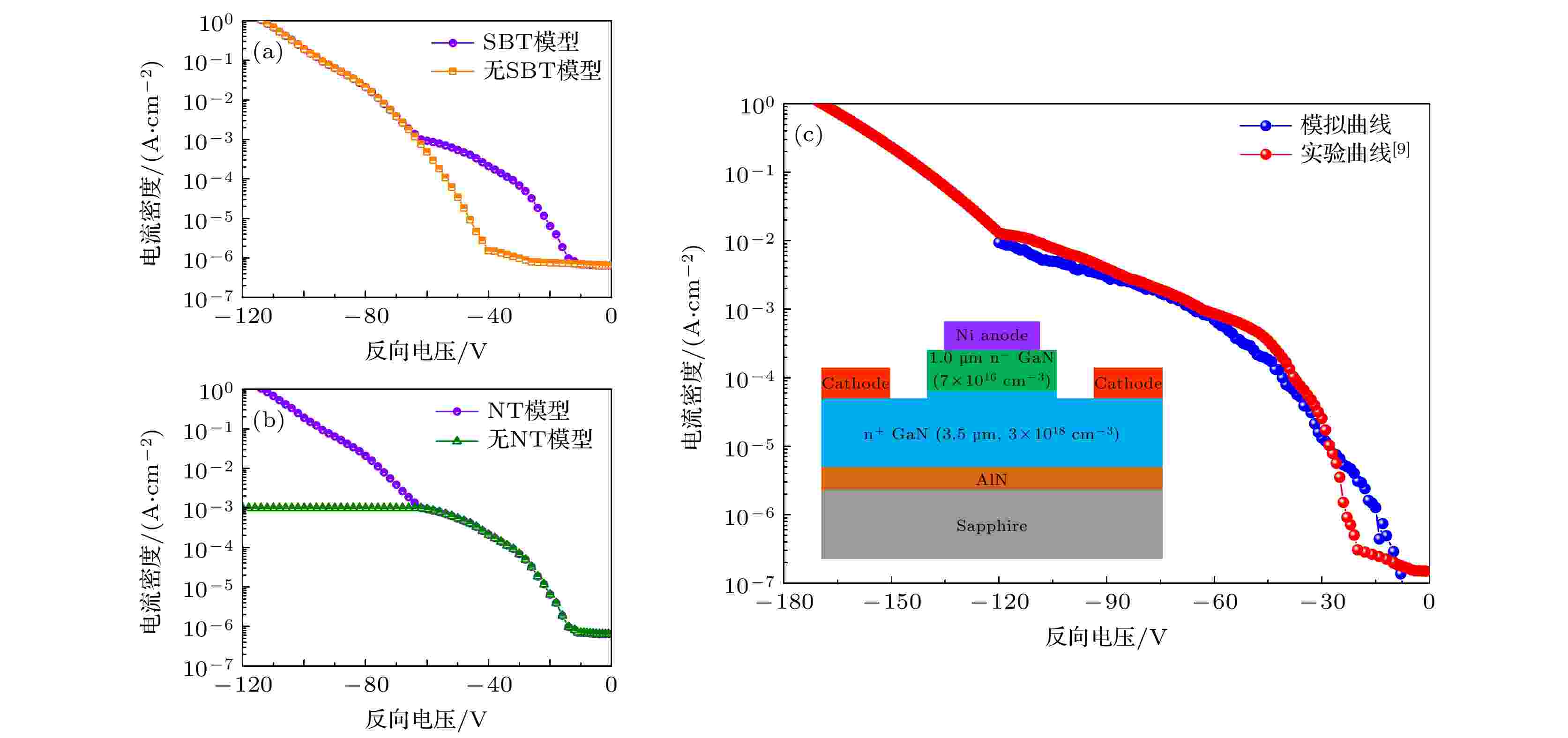
2022, 71 (5): 057301.
doi:10.7498/aps.71.20211917
Abstract +
Quasi-vertical GaN barrier Schottky diodes have attracted much attention due to their low cost and high current transfer capability. The main problem is that the reverse characteristics of the devices may not be well estimated, which affects the design of the diodes. In this paper, the defects of GaN materials and the leakage related tunneling mechanisms accompanied with other mechanisms are considered. Based on the established composite device models, the reverse leakage current is simulated which is well consistent with the recent experimental result. With the assistance of the proposed models, several field plate structures are discussed and simulated to obtain a quasi-vertical GaN barrier Schottky diode with high breakdown voltage. The major leakage mechanisms are also analyzed according to the relation among leakage current, temperature and electric field at various reverse voltages. High BFOM up to 73.81 MW/cm2is achieved by adopting the proposed stepped field plate structure.
INTERDISCIPLINARY PHYSICS AND RELATED AREAS OF SCIENCE AND TECHNOLOGY
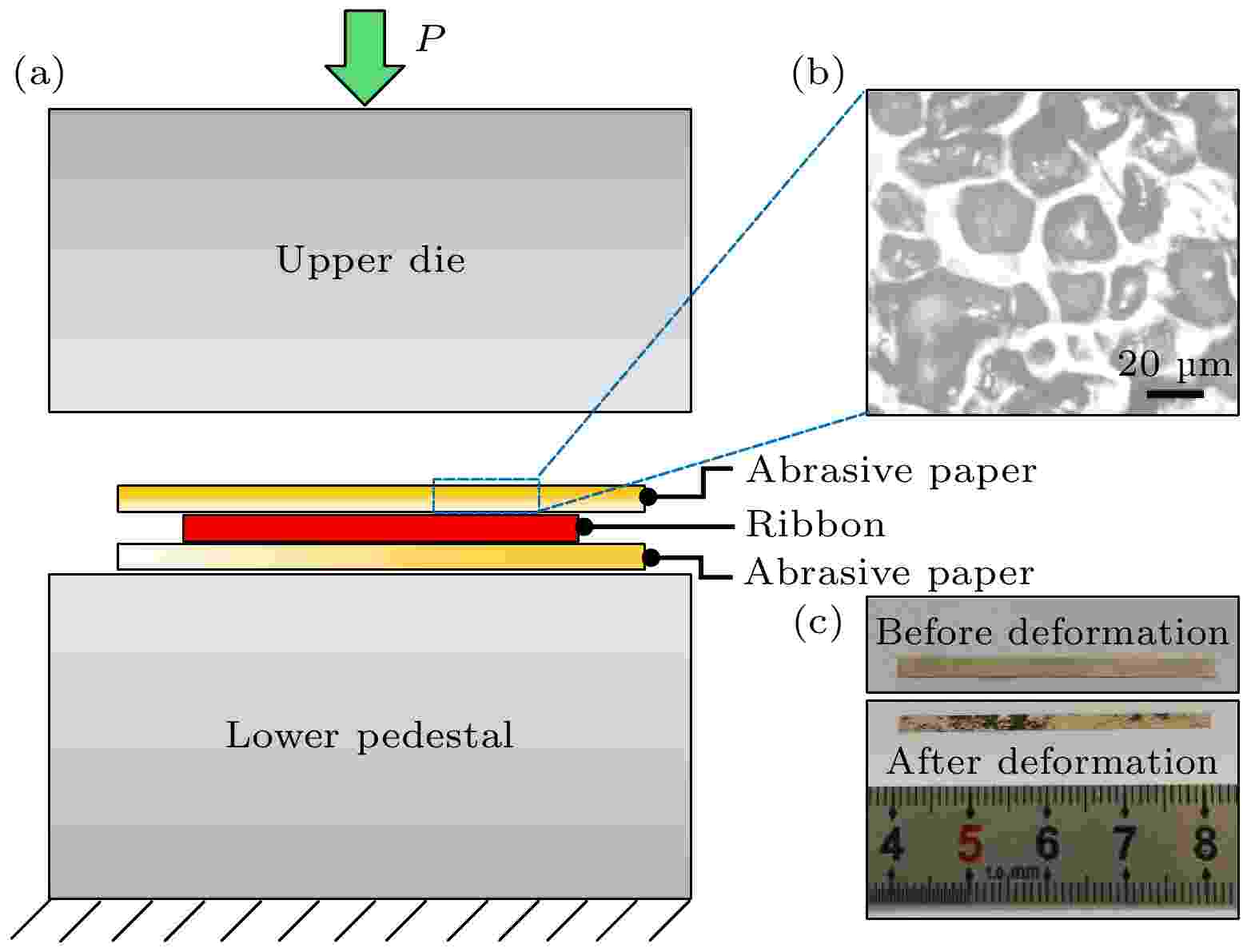
EDITOR'S SUGGESTION
2022, 71 (5): 058101.
doi:10.7498/aps.71.20211304
Abstract +
The atomic-scale structure and concomitant mechanical property evolution of a ribbon-shaped Fe78Si9B13metallic glass after local plastic flow are investigated. By using abrasive papers as a medium to transport the pressure, the equivalent pressure on the ribbon surface is sufficiently magnified. Multiple shear bands pervading along their surface are generated simultaneously after deformation. The densification processes triggered by the cooperative atomic rearrangements in the short and medium-range are revealed by analyzing the synchrotron diffraction patterns in reciprocal space and real space. Meanwhile, the local plastic flow enhances the structural heterogeneity. In contrast to the strain-softening under uniaxial loading, these structural changes contribute to the improvement of resistance to subsequent deformation. As a result, the Vickers hardness of the deformed Fe78Si9B13metallic glass increases compared with the undeformed sample, manifesting a local strain-hardening behavior.
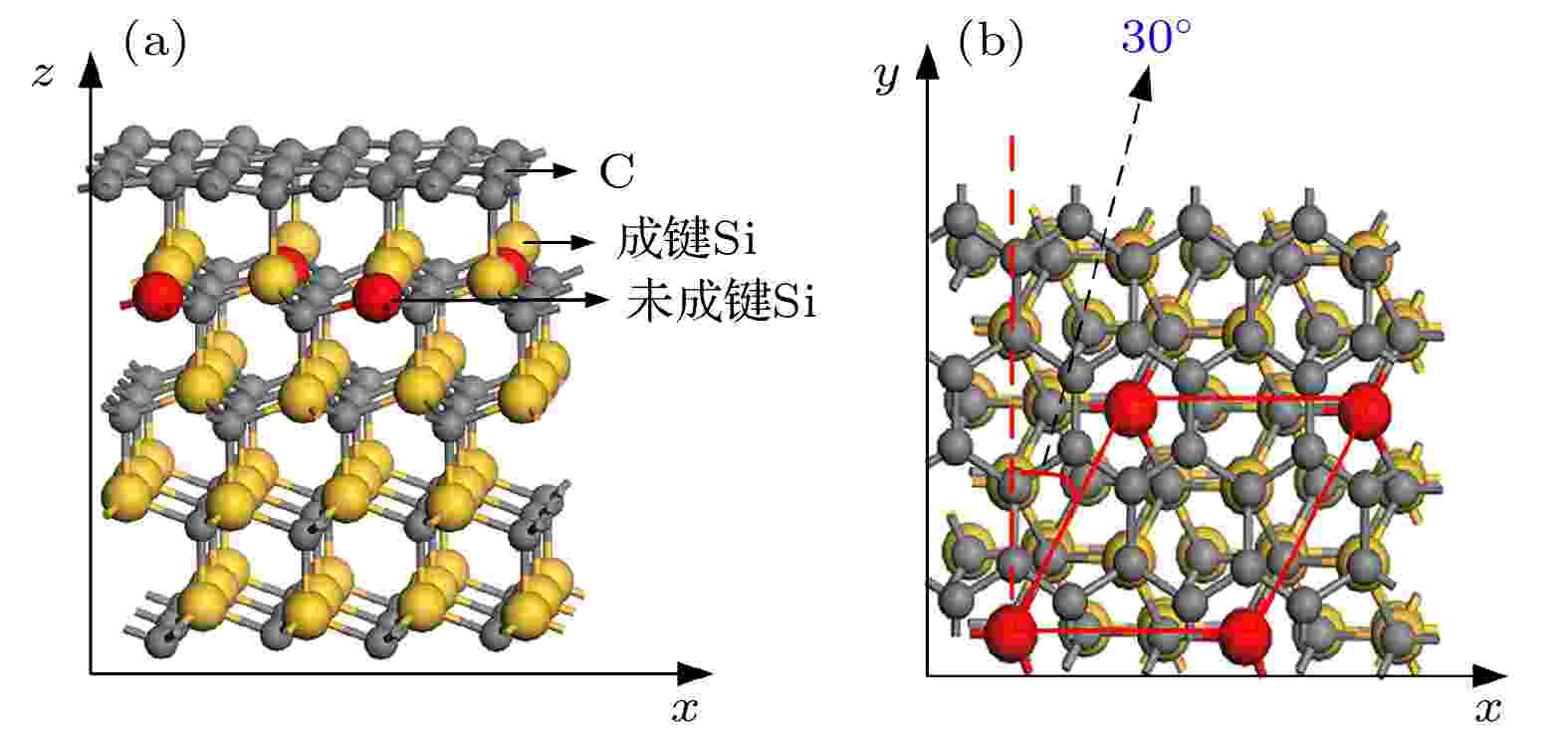
2022, 71 (5): 058102.
doi:10.7498/aps.71.20211796
Abstract +
In the production of SiC electronic devices, one of the main challenges is the fabrication of good Ohmic contacts due to the difficulty in finding the metals with low Schottky barriers of wide band gap SiC. Therefore, reducing the Schottky barrier height (SBH) at the metal/SiC interface is of great importance. In this paper, the effects of graphene intercalation on the SBH in different metals (Ag, Ti, Cu, Pd, Ni, Pt)/4H-SiC interfaces are studied by combining the average electrostatic potential and local density of states calculation methods based on first-principles plane wave pseudopotential density functional theory. The calculation results show that single-layer graphene intercalation can reduce the SBH of metal/4H-SiC contact. When the two layers of graphene are inserted, the SBH are further reduced. Especially, the contact between Ni and Ti exhibits negative SBH values, inferring that good Ohmic contacts are formed. When layers of graphene continue to increase, the SBH no longer changes obviously. By analyzing the differential charge density and the local density of states of the interface, the mechanism of SBH reduction may be that the dangling bonds on the SiC surface are saturated by the graphene C atoms and the influence of the metal-induced energy gap state at the interface is reduced, thereby reducing the interface state density. In addition, graphene and the corresponding new phases at the interface have low work functions. Moreover, an interfacial electric dipole layer may be formed at the SiC/graphene interface which also contributes to barrier reduction.

2022, 71 (5): 058501.
doi:10.7498/aps.71.20211694
Abstract +
Nanoporous superconducting films with superconductor-insulator transition characteristics have potential application in the field of infrared photoelectric detection, but their broadband optical response characteristics in infrared band have not been reported. Therefore, taking nanoporous niobium nitride (NbN) films as the main object, the optical response characteristics in the near and medium infrared wavelength range of 780–5000 nm are studied in this paper. Firstly, the Drude-model fitting accuracy of measured NbN permittivity is improved by about 17%, and the NbN optical parameters in mid-infrared band are obtained. Furthermore, the optical response characteristics of the back-illuminated device with nanoporous NbN film are analyzed by finite difference time domain method, and a Bruggeman equivalent model which can simplify the nanoporous film into a uniform film is given, thereby reducing the three-dimensional simulation of nanoporous NbN film into one dimensional simulation. Finally, based on the equivalent model and the transfer matrix method, the light absorption characteristics of the back-illuminated device in near-/mid-infrared wavelength ranges are optimized. The results indicate that, on the one hand, simplifying the design process by using Bruggeman equivalent model will not affect the correctness of the final optimization results, and, on the other hand, a relatively simple optical cavity can make the detector achieve polarization-independent film absorption greater than 82% for near-/mid-infrared broadband design and 93.7% for double-wavelength design.

Three-dimensional simulation of total ionizing dose effect on SiGe heterojunction bipolor transistor
2022, 71 (5): 058502.
doi:10.7498/aps.71.20211795
Abstract +
The damage mechanism of the total ionizing dose (TID) effect of SiGe heterojunction bipolor transistar (SiGe HBT) is explored by using three-dimensional simulation of semiconductor device (TCAD).In the simulation, the trapped charge defects are introduced into different locations of oxidationin SiGe HBT to simulate the TID effect. Then the degradation characteristics of the forward Gummel characteristic and the reverse Gummel characteristic of the device are analyzed, and the TID damage law of SiGe HBT is obtained. Finally, the simulation results are compared with the60Co γ irradiation test results, showing that the trapped charges introduced by TID irradiation in SiGe HBT device mainly affect the Si/SiO2interface near the p-n junction, resulting in the change in the depletion region of the p-n junction and the increase of carrier recombination. Eventually, the base current increases and the gain decreases. The trapped charges generated in the EB spacer oxide layer mainly affect the forward Gummel characteristics, and the trapped charges in the LOCOS isolation oxide layer are the main factor causing the reverse Gummel characteristics to degrade. The experimental results on60Co γ irradiation under different biases are consistent with those from the total dose effect damage law of SiGe HBT obtained by numerical simulation analysis.

2022, 71 (5): 058503.
doi:10.7498/aps.71.20211350
Abstract +
In this paper, the rare earth element praseodymium-doped indium tin zinc oxide semiconductor is used as the channel layer of the thin film transistor, and the aluminum oxide-based wet back channel etched thin film transistor is successfully prepared. The effect of N2O plasma treatment on the back-channel interface of thin film transistor is studied, and the effect of treatment power and time on device performance are studied in detail. The results show that the good device performance can be obtained under certain power and time treatment, and the prepared device has good thermal stability of positive bias and negative bias under light conditions. The results from high-resolution transmission electron microscopy show that the amorphous structure of the metal oxide semiconductor material can effectively resist the wet etchant, and that no obvious component segregation phenomenon is found. Further, X-ray photoelectric spectroscopy tests show that N2O plasma treatment can form an oxygen-rich, low-carrier-concentration interface layer at the interface. On the one hand, it can effectively resist the damage of the back channel caused by the plasma of plasma enhanced chemical vapor deposition (PECVD), and on the other hand, it acts as a passivation body of hydrogen from PECVD plasma, suppressing the generation of low-level donor state of hydrogen. This study provides an important reference for low-cost, high-efficiency thin film transistor performance optimization methods.
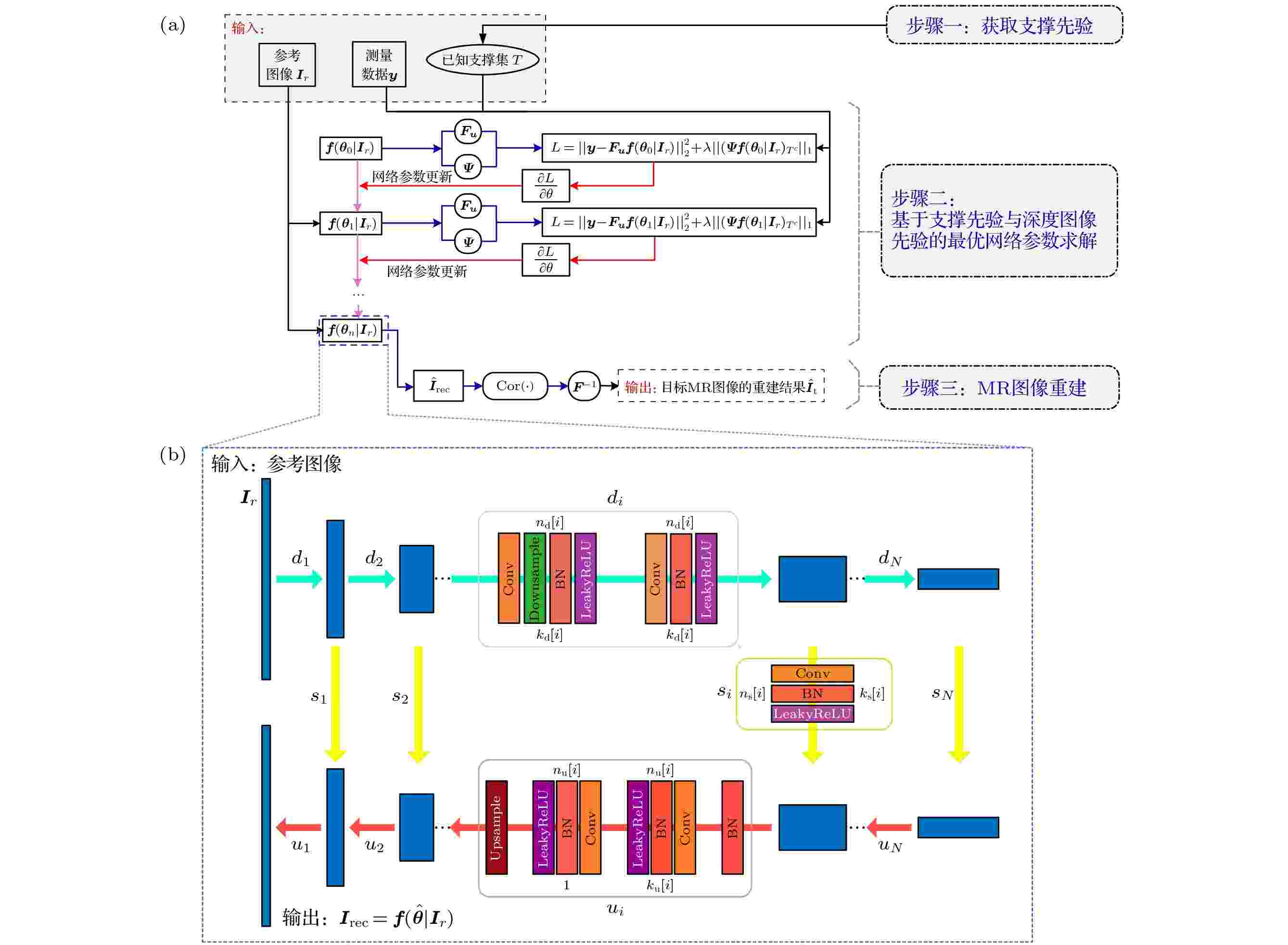
2022, 71 (5): 058701.
doi:10.7498/aps.71.20211761
Abstract +
Magnetic resonance imaging (MRI) method based on deep learning needs large-quantity and high-quality patient-based datasets for pre-training. However, this is a challenge to the clinical applications because it is difficult to obtain a sufficient quantity of patient-based MR datasets due to the limitation of equipment and patient privacy concerns. In this paper, we propose a novel undersampled MRI reconstruction method based on deep learning. This method does not require any pre-training procedures and does not depend on training datasets. The proposed method is inspired by the traditional deep image prior (DIP) framework, and integrates the structure prior and support prior of the target MR image to improve the efficiency of learning. Based on the similarity between the reference image and the target image, the high-resolution reference image obtained in advance is used as the network input, thereby incorporating the structural prior information into network. By taking the coefficient index set of the reference image with large amplitude in the wavelet domain as the known support of the target image, the regularization constraint term is constructed, and the network training is transformed into the optimization process of network parameters. Experimental results show that the proposed method can obtain more accurate reconstructions from undersampledk-space data, and has obvious advantages in preserving tissue features and detailed texture.
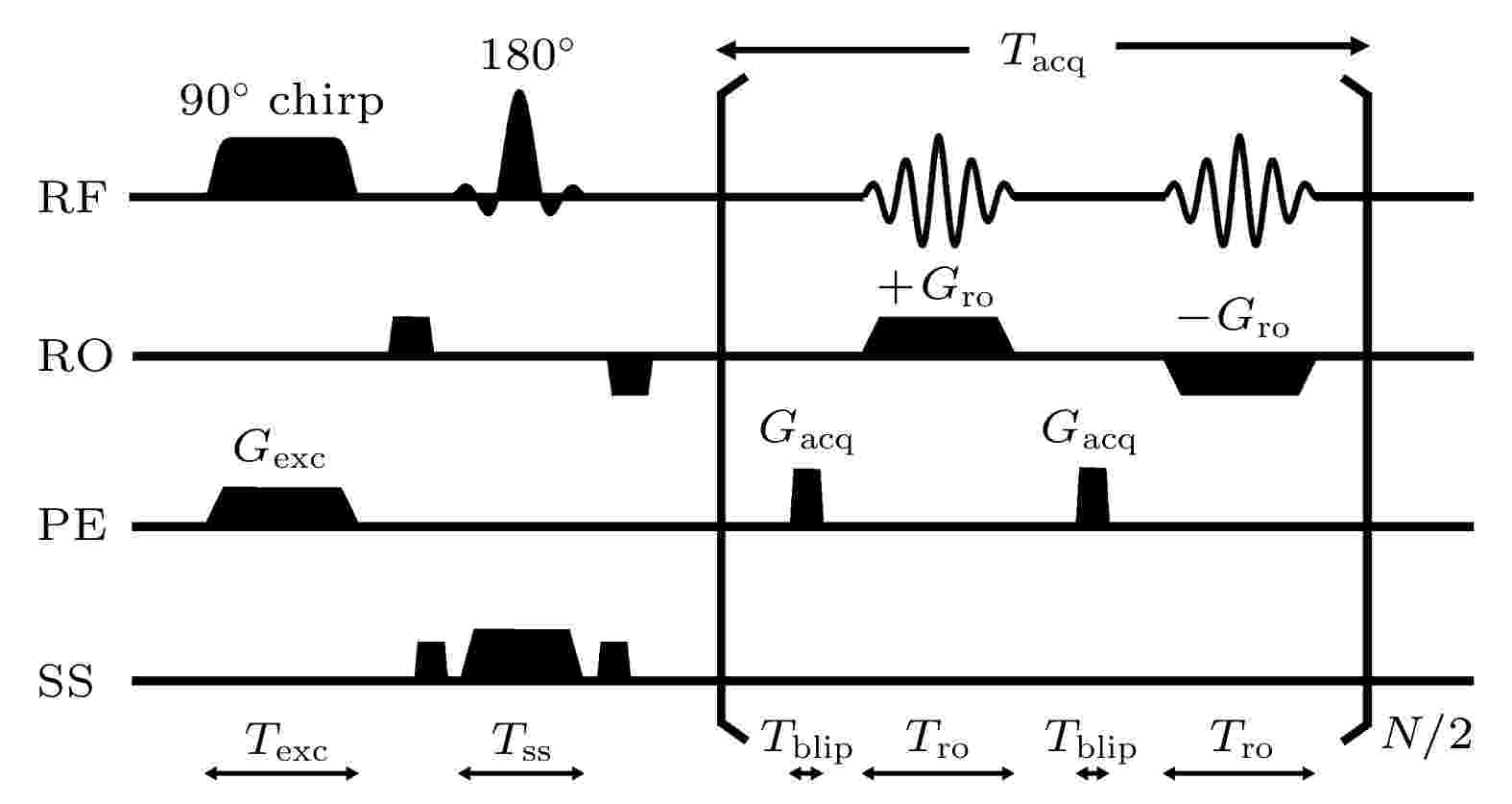
EDITOR'S SUGGESTION
2022, 71 (5): 058702.
doi:10.7498/aps.71.20211754
Abstract +
Single-shot spatiotemporally-encoded magnetic resonance imaging (SPEN MRI) is a novel ultrafast MRI technology. The SPEN MRI possesses great resistance to inhomogeneousB0magnetic field and chemical shift effect. However, it has inherently low spatial resolution, and the super-resolved reconstruction is required to improve the spatial resolution of SPEN MRI image without additional signal acquisition. Several super-resolved reconstruction methods have been proposed, but they all suffer the problems of long iterative solution time and/or aliasing artifacts residue in the reconstructed results. In this paper, a super-resolved reconstruction method is proposed for single-shot SPEN MRI based on deep neural network. In this method the simulation samples are used to train the deep neural network, and then the trained network model is adopted to reconstruct the real sampled signals. Experimental results of numerical simulation, water phantom and in vivo rat brain show that this method can quickly reconstruct a super-resolved SPEN image with no residual aliasing artifacts, and clear texture information. An appropriate number of training samples and an appropriate random noise level for training samples contribute to improving the reconstruction results.
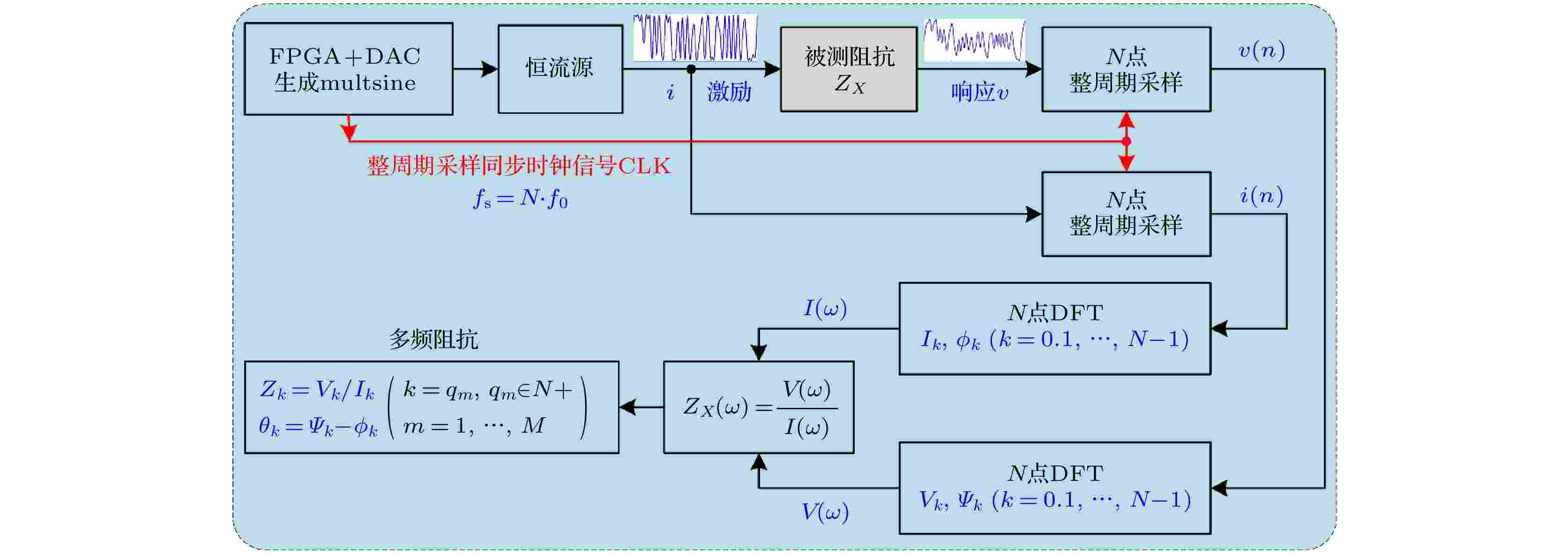
2022, 71 (5): 058703.
doi:10.7498/aps.71.20211375
Abstract +
Starting from the principle that the integer-period sampling (IPS) of periodic signals is free of spectrum leakage, in this paper we propose the multisine-IPS theory, deduce theoretically the sampling rate setting formula of multisine-IPS condition for the first time, and build its realization method based on field-programmable gate array (FPGA) plus digital-to-analog converter (DAC) plus analog-to-digital converter (ADC). A new multi-frequency electrical impedance tomography (mfEIT) system based on multisine excitation and its IPS theory is developed, and a dual-target imaging model including a carrot stick and a cucumber stick is designed. The experiments of multi-frequency time-difference imaging and frequency-difference imaging are carried out on the mfEIT system. The experimental results show that the newly-designed mfEIT system can achieve full-band impedance measurements on multiple objective tissue boundary at 20 frequency points (2–997 kHz) within one fundamental period (1 ms), and the structure and position of biological tissues with different electrical properties can also be distinguished from the resulting images. The proposed multisine-IPS theory and its implementation method can complete a full-band impedance measurement within one multisine fundamental period, which lays a theoretical and technical foundation for developing high-speed mfEIT system.
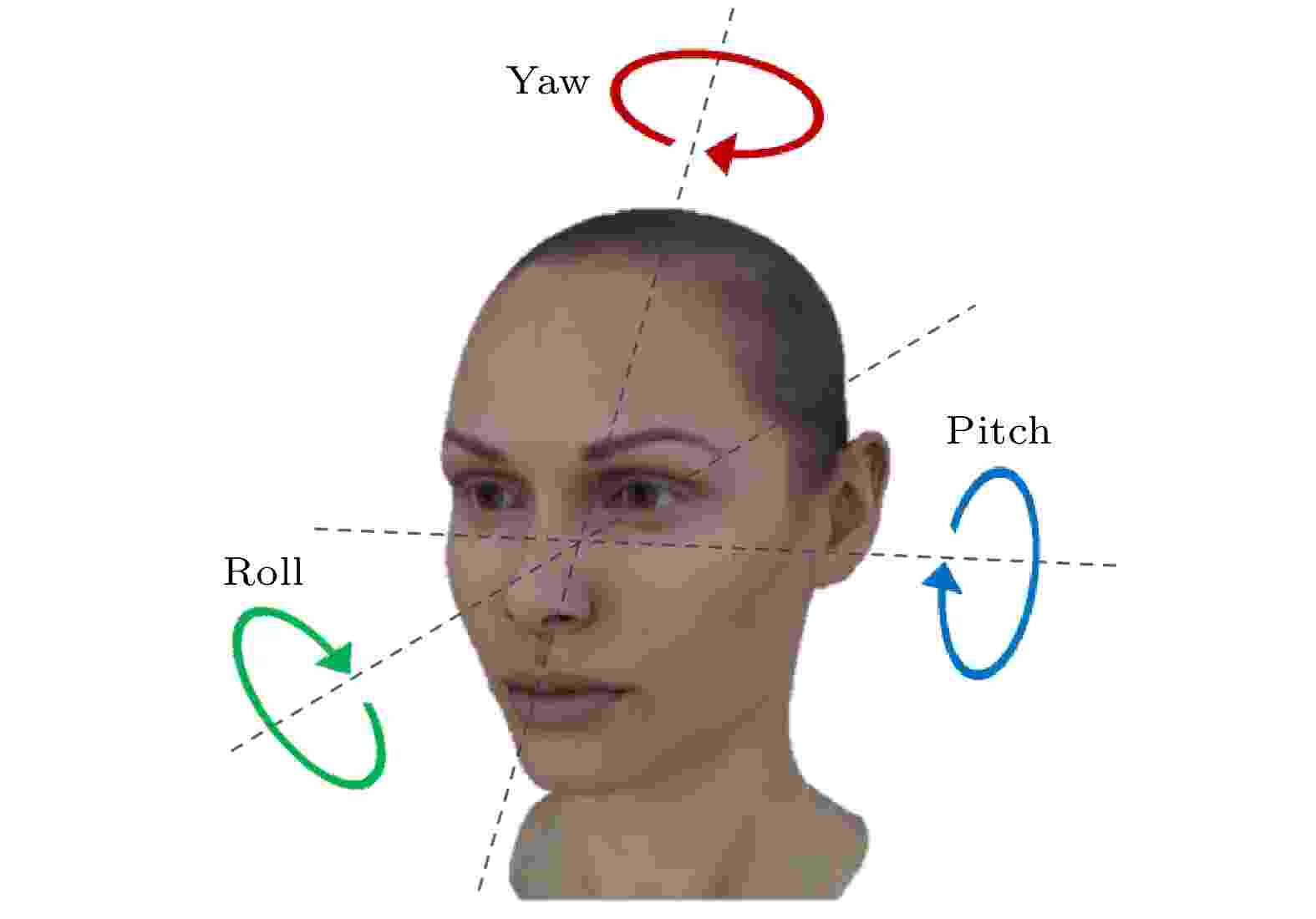
2022, 71 (5): 058704.
doi:10.7498/aps.71.20211634
Abstract +
The dominant challenge of vital signal monitoring based on facial video is to eliminate the interference of motion artifacts. In this paper, we propose a non-contact heart rate detection method based on an adaptive filter constructed by head movement information to tackle the noise of motion artifacts caused by the rigid rotation of the subject's head. The two-dimensional and three-dimensional feature points of the subject’s face are used to calculate the yaw and pitch Euler angles of the head movement, then the yaw and pitch Euler angles are used as a novel signal quality index (SQI) for modulating process noise covariance to construct an adaptive Kalman filter, and finally robust heart rate is estimated by this method. The experimental results show that the proposed method can effectively suppress the noise caused by the head rigid rotation with an average absolute error of 2.22 beat/min and a root mean square error of 2.76 beat/min, which are statistically significant with an accuracy improvement of 9% and 24.6%, respectively, compared with the existing methods. The adaptive non-contact robust heart rate detection technique based on head rigid rotation may effectively enhance the accuracy in real-world motion situations, as well as broaden the range of applications for IPPG in the field of the video-based monitoring of health conditions.
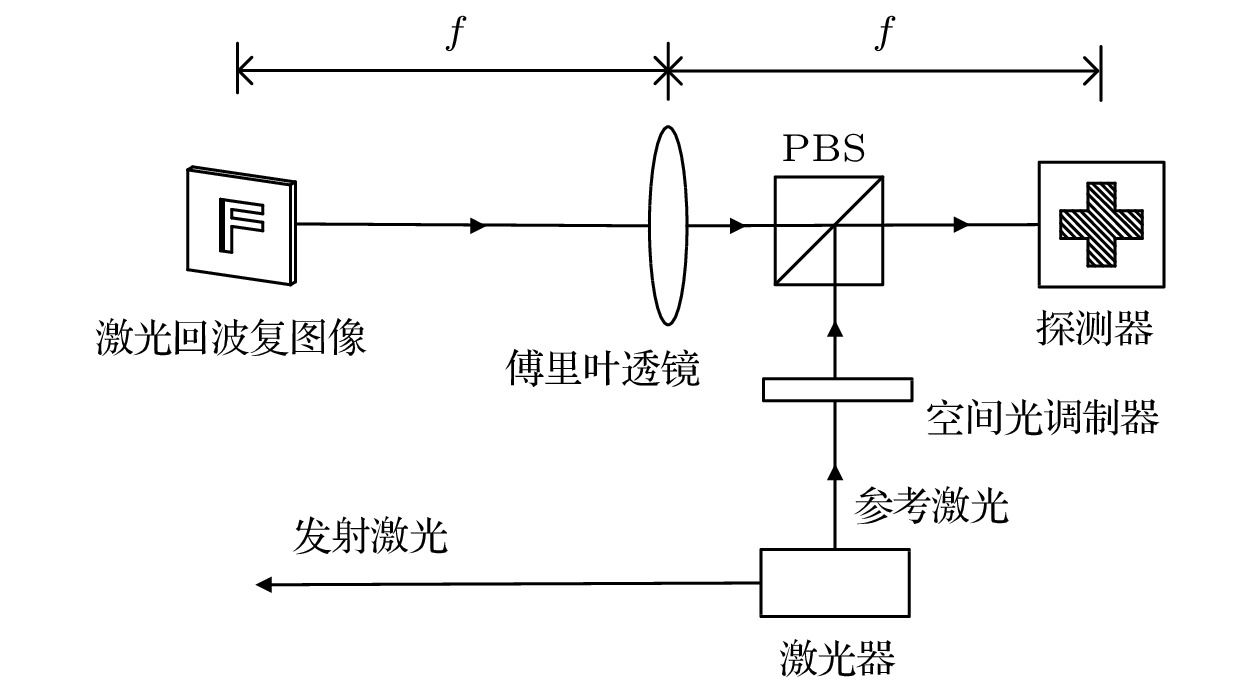
2022, 71 (5): 058705.
doi:10.7498/aps.71.20211408
Abstract +
The monochromaticity of the laser and the characteristics of the natural image’s spectrum, including sparsity and concentrating in the low frequency range, make it possible to sample the image spectrum sparsely. Based on small-scale laser detectors and the introduced laser reference signals, a method of laser imaging with sparse sampling in frequency domain is proposed in this paper. The principle of frequency sparse sampling laser imaging and the imaging system structure are introduced. The simulation results of spectrum and complex images reconstructed are given. Both the effects of the signals’ parameters, such as the ratio of the reference laser signal amplitude to the laser echo spectrum amplitude and the initial phase of the laser reference signal, on reconstruction results are investigated. The reconstruction results are evaluated by correlation coefficient, mean square error (MSE), and structural similarity index (SSIM). For the strong correlation between phase and amplitude of the laser echo complex image, the amplitude image and the phase image are both set to be 256 × 256 diagram. The sparse laser detector plane array consists of 5 64 × 64 frequency domain laser detector arrays, which form a cross and make a sparsity rate of 31.25%(5/16). The simulation results show that the correlation coefficient, MSE and SSIM of the spectrum reconstructed are 0.96, 22.14, 1.00 and those of the complex image reconstructed are 0.96, 1857.25 and 0.67 respectively. The simulation results indicate that the method proposed is effective. However, the method requires the laser reference signal amplitude to be about 30 times the mean value of the laser echo spectrum amplitude, which reduces the dynamic range of the detectors. The initial phase of the laser reference signal has no obvious effect on the reconstruction results.










